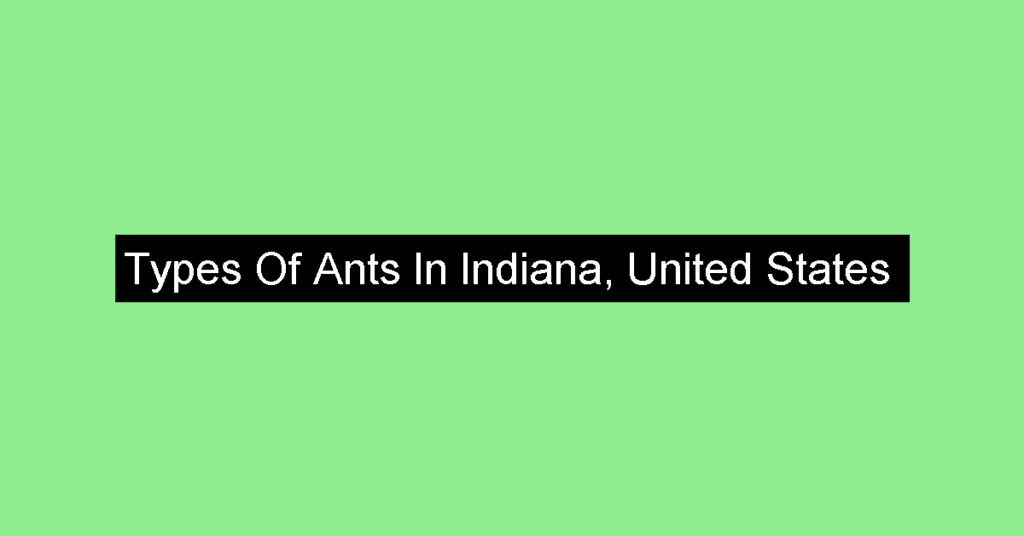Indiana, located in the Midwestern region of the United States, is a state known for its diverse landscape and unique climate. The state is home to a variety of ecosystems, ranging from dense forests to expansive prairies, providing habitats for a wide range of animal species.
The weather in Indiana is characterized by four distinct seasons, with hot summers and cold winters. The state experiences a range of weather phenomena, including thunderstorms, tornadoes, and occasional blizzards.
Indiana is home to a variety of wildlife, including deer, coyotes, foxes, and a variety of bird species. The state’s natural environment is a source of pride for its residents and attracts visitors from around the world.
.
Types Of Ants In Indiana, United States
The Types Of Ants In Indiana, United States are listed here: Funnel Ants, Rover Ants, Carpenter And Sugar Ants, Acrobat Ants, Discothyrea, Dolly Ants, Pyramid Ants, Forelius, Wood Ants, Formicoxenus, Harpagoxenus, Crypt Ants, Moisture Ants, Leptothorax, Trailing Pharaoh And Timid Ants, Mite-Eating Ants, Furrowed Ants, Army Ants, Crazy Ants, Crazy Ants, Big Headed Ants, Typical American Harvester Ants, Amazon Ants, Porthole Ants, Winter Ants, Hairy Curltail Ants, Protomognathus, Fire Ants, Leaf-Litter Ants, Vampire Ants, Miniature Trap-Jaw Ants, Tapinoma, Slave-Making Ants, Pavement Ants, Trachymyrmex, Tawny Collared Ants, Notched Collared Ants, Marys Collared Ants, Winnow Ants, Tennessee Collared Ants, Treats Winnow Ants, Hairless Rover Ants, Chestnut Carpenter Ants, Carpenter And Sugar Ants, Smaller Carpenter Ants, Carpenter Ants, Black Carpenter Ants, Carpenter And Sugar Ants, Acrobat Ants, Acrobat Ants, Wood Ants, Silky Ants, Wood Ants, Wood Ants, Western Thatching Ants, Northern Red Wood Ants, Pale Field Ants, Wood Ants, Wood Ants, Ruddy Slave-Making Mound Ants, Obligate Slave-Making Mound Ants, Wood Ants, Cornfield Ants, Moisture Ants, Yellow Meadow Ants, Larger Citronella Ants, Wide-Legged Citronella Ants, Labour Day Ants, Black Garden Ants, Moisture Ants, Yellow Shadow Ants, Little Black Ants, American Mite-Eating Ants, Furrowed Ants, Punctured Ants, Big Headed Ants, Hairy Big Headed Ants, Amazon Ants, Amazon Ants, Western Amazon Ants, Amazon Ants, Pennslyvanian Hunter Ants, Small Honey Ants, Spider Egg Ants, Thief Ants, Northern Thief Ants, Leaf-Litter Ants, Vampire Ants, Miniature Trap-Jaw Ants, Miniature Trap-Jaw Ants, Miniature Trap-Jaw Ants, Miniature Trap-Jaw Ants, Miniature Trap-Jaw Ants, Miniature Trap-Jaw Ants, Miniature Trap-Jaw Ants, Miniature Trap-Jaw Ants, Rogers Dacetine Ants, Miniature Trap-Jaw Ants, Miniature Trap-Jaw Ants, Slave-Making Ants, Small Yellow Ants, Slave-Making Ants.
If you’ve found some other ants in this region, contact us, and we will add them to the list!
1) Funnel Ants, Aphaenogaster
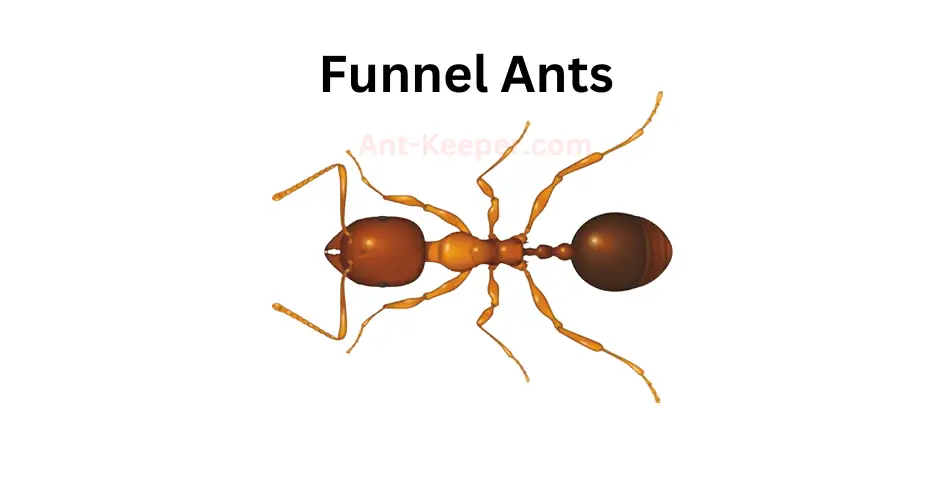
The Funnel Ants, also known as Aphaenogaster ants, are a species of ants that are commonly found in various habitats around the world.
These ants are known for their unique nesting behavior, where they construct funnel-shaped nests that are typically located in soil or leaf litter.
The Funnel Ants are relatively small in size, with workers measuring between 3-5mm in length.
They are typically reddish-brown in color and have a slender body shape.
These ants are known for their strong mandibles, which they use to collect and transport food back to their nests.
One of the most interesting aspects of the Funnel Ants is their nesting behavior.
These ants construct funnel-shaped nests that are typically located in soil or leaf litter.
The entrance to the nest is narrow and funnel-shaped, which helps to protect the colony from predators and other threats.
Inside the nest, the ants create a series of chambers and tunnels that are used for different purposes, such as storing food, caring for the brood, and housing the queen.
The Funnel Ants are omnivorous, meaning that they feed on both plant and animal matter.
They are known to collect a wide variety of food items, including seeds, insects, and other small invertebrates.
These ants are also known to tend to aphids, which they use for their honeydew secretion.
Overall, the Funnel Ants are a fascinating species of ants that are known for their unique nesting behavior and omnivorous diet.
They play an important role in their ecosystems, helping to control populations of other insects and contributing to nutrient cycling in the soil.
2) Rover Ants, Brachymyrmex
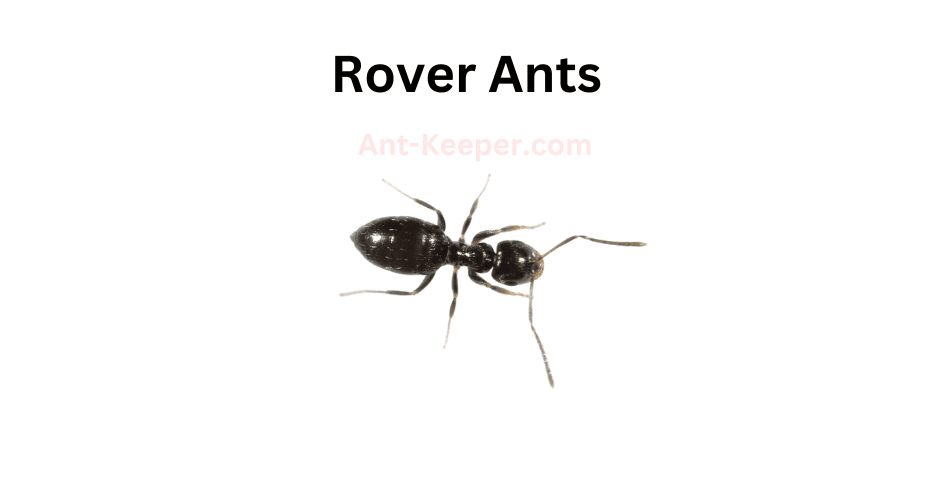
Rover ants, also known as Brachymyrmex spp., are a species of small, dark-colored ants that are commonly found in urban and suburban areas.
These ants are known for their ability to quickly move their nests from one location to another, hence their name "rover ants."
Rover ants are typically between 1.5 and 2.5 millimeters in length and have a dark brown or black coloration.
They have a slender body with a distinct waist and long, thin legs.
These ants are known for their aggressive behavior towards other ant species and will often invade and take over their nests.
Rover ants are omnivorous and will feed on a variety of food sources, including insects, sweets, and plant material.
They are also known to be attracted to human food and can become a nuisance in homes and other buildings.
One unique characteristic of rover ants is their ability to form "supercolonies." These supercolonies can consist of multiple nests and can span large areas.
This behavior allows rover ants to quickly adapt to changing environments and find new food sources.
Overall, rover ants are a common and adaptable species that can be found in many different environments.
While they can be a nuisance in homes and other buildings, they play an important role in the ecosystem as scavengers and predators of other insects.
3) Carpenter And Sugar Ants, Camponotus

Carpenter ants and sugar ants are two common species of ants found in many regions of the world.
Carpenter ants are known for their ability to excavate wood and create nests within it.
They are typically larger in size than sugar ants and have a black or dark brown coloration.
Carpenter ants are also known for their strong mandibles, which they use to chew through wood and other materials.
Sugar ants, on the other hand, are smaller in size and have a yellow or brown coloration.
They are named for their preference for sugary foods and are often found in kitchens and other areas where food is stored.
Sugar ants are also known for their ability to form large colonies, with thousands of individual ants working together to gather food and care for their young.
Both carpenter ants and sugar ants play important roles in their ecosystems.
Carpenter ants help to break down dead wood and other plant material, which helps to recycle nutrients back into the soil.
Sugar ants help to disperse seeds and pollinate plants, which helps to maintain healthy ecosystems.
However, both species can also be pests when they invade human homes and buildings.
Carpenter ants can cause damage to wooden structures, while sugar ants can contaminate food and be a nuisance to homeowners.
It is important to take steps to prevent ant infestations and to control them if they do occur, in order to protect both human health and the health of the environment.
4) Acrobat Ants, Crematogaster

Acrobat ants, also known as Crematogaster spp., are a genus of ants that are found in various parts of the world.
These ants are known for their unique ability to contort their bodies and move in acrobatic ways, hence their name.
Acrobat ants are relatively small, with workers measuring between 2-5mm in length.
They are typically brown or black in color, with a slender body and long legs.
These ants are known for their aggressive behavior and will readily defend their nests against intruders.
One of the most interesting features of acrobat ants is their ability to use their mandibles to grip onto surfaces and contort their bodies in unusual ways.
This allows them to move along narrow branches, twigs, and other surfaces that would be difficult for other ants to navigate.
They are also able to use this ability to escape from predators, such as birds and other insects.
Acrobat ants are omnivorous, meaning that they will eat both plant and animal matter.
They are known to feed on insects, nectar, and honeydew, as well as fruits and seeds.
These ants are also known to tend to aphids, protecting them from predators in exchange for the sweet honeydew that the aphids produce.
In terms of their social structure, acrobat ants are typically organized into colonies that are led by a queen.
The queen is responsible for laying eggs, while the workers are responsible for foraging, caring for the young, and defending the nest.
Overall, acrobat ants are fascinating creatures that have adapted unique abilities to survive in their environments.
Their acrobatic abilities and aggressive behavior make them a formidable force in the insect world.
5) Discothyrea
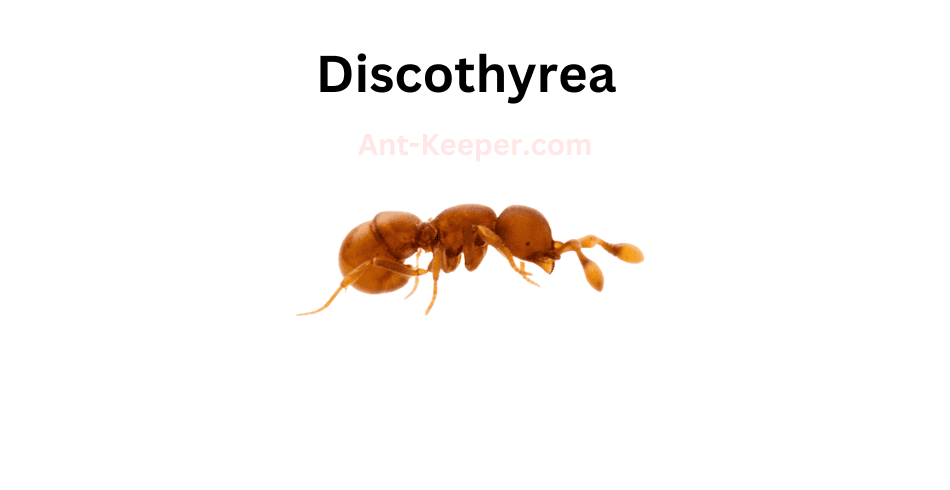
Discothyreabe is a species of ant that belongs to the Formicidae family.
These ants are known for their unique physical characteristics, including their elongated mandibles and slender bodies.
The workers of this species are typically around 3-4mm in length, while the queen can grow up to 7mm.
Discothyreabe ants are primarily found in forested areas, where they build their nests in soil or leaf litter.
They are known to be aggressive towards other ant species and will defend their territory fiercely.
These ants are also known to be nocturnal, which means they are most active during the night.
One of the most interesting aspects of Discothyreabe ants is their feeding habits.
They are known to be generalist feeders, which means they will eat a wide variety of foods.
They have been observed feeding on insects, nectar, and even carrion.
This adaptability allows them to thrive in a variety of environments.
Despite their small size, Discothyreabe ants play an important role in their ecosystem.
They help to control insect populations and contribute to soil health through their nest-building activities.
They are also an important food source for many other animals, including birds and small mammals.
Overall, Discothyreabe ants are a fascinating species that have adapted to thrive in a variety of environments.
Their unique physical characteristics and feeding habits make them an important part of their ecosystem.
6) Dolly Ants, Dolichoderus
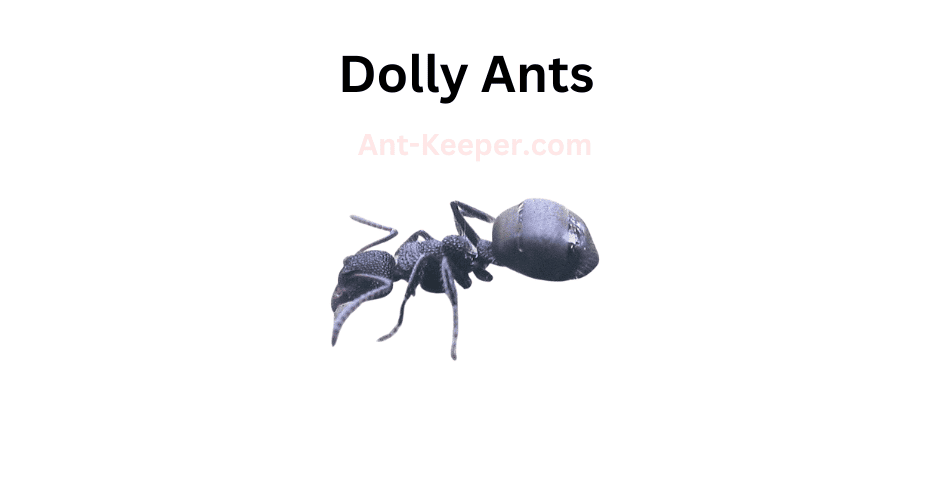
Dolly Ants, also known as Dolichoderus spp., are a species of ant that belong to the family Formicidae.
These ants are known for their distinctive elongated heads and bodies, which give them a unique appearance compared to other ant species.
Dolly Ants are typically found in forested areas, where they build their nests in soil or under rocks.
They are known to be highly social insects, living in large colonies that can contain thousands of individuals.
Within these colonies, there is a strict division of labor, with different ants taking on specific roles such as foraging, caring for the young, and defending the colony.
One interesting aspect of Dolly Ant behavior is their use of chemical communication.
These ants use pheromones to communicate with each other, leaving trails of scent that other ants can follow to locate food sources or to find their way back to the nest.
They also use pheromones to signal danger, which can trigger a coordinated response from the colony to defend against predators.
Dolly Ants are omnivorous, feeding on a variety of foods including insects, nectar, and plant sap.
They are also known to have a mutualistic relationship with certain plant species, where they protect the plants from herbivores in exchange for a source of food.
Overall, Dolly Ants are a fascinating species of ant with unique physical and behavioral characteristics.
Their social structure and use of chemical communication make them an important subject of study for researchers interested in understanding the behavior of social insects.
7) Pyramid Ants, Dorymyrmex
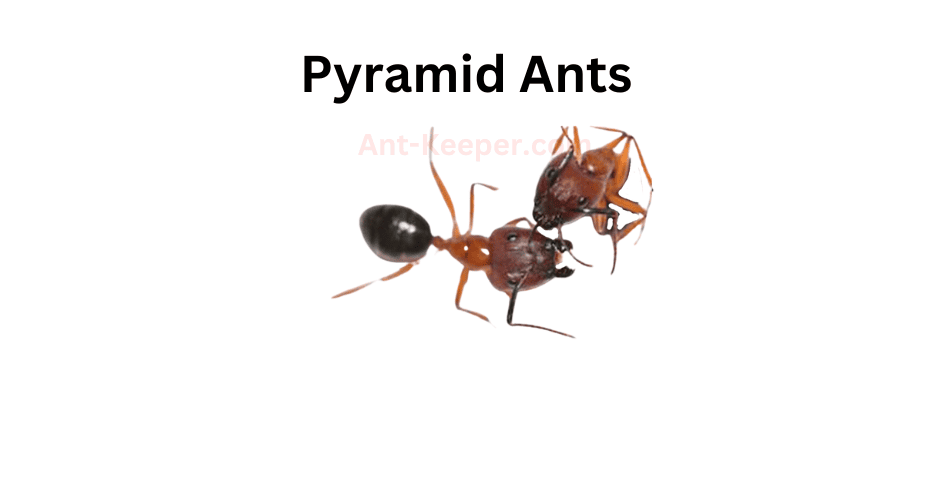
Pyramid ants, also known as Dorymyrmex pyramicus, are a species of ant that belongs to the family Formicidae.
These ants are commonly found in dry and arid regions, where they build their nests in the form of small pyramids made of sand or soil.
The workers of pyramid ants are small, measuring around 3-4 mm in length, and are reddish-brown in color.
They have a slender body with long legs and antennae, which they use to communicate with each other through chemical signals.
Pyramid ants are known for their aggressive behavior towards other ant species and insects that invade their territory.
They use their strong mandibles to defend their nest and food sources, and can deliver a painful sting if threatened.
These ants are omnivorous, feeding on a variety of food sources including insects, seeds, and nectar.
They are also known to tend to aphids, which they protect from predators in exchange for the sweet honeydew that the aphids produce.
Pyramid ants are important members of their ecosystem, playing a role in seed dispersal and soil aeration.
They are also preyed upon by a variety of animals, including birds, lizards, and other insects.
Overall, pyramid ants are fascinating creatures that have adapted to survive in harsh and arid environments.
Their unique nesting behavior and aggressive nature make them an interesting species to study and observe in the wild.
8) Forelius
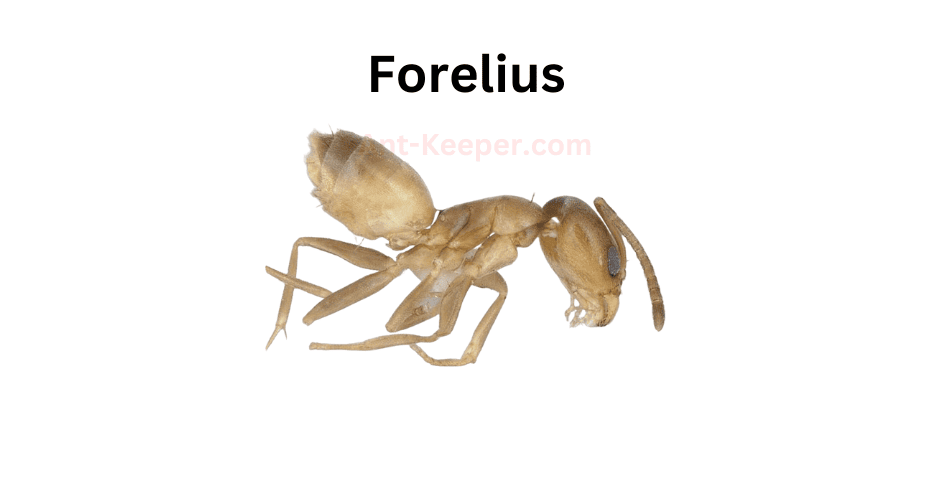
Forelius is a genus of ants that belongs to the family Formicidae.
These ants are commonly found in arid and semi-arid regions, and they are known for their small size and aggressive behavior.
Forelius ants are typically yellow or brown in color, and they have a slender body with long legs and antennae.
Forelius ants are social insects that live in colonies.
The colonies are usually small, with only a few hundred individuals, and they are often found nesting in the soil or under rocks.
The ants are omnivorous, and they feed on a variety of foods, including insects, nectar, and seeds.
One of the most interesting aspects of Forelius ants is their aggressive behavior.
These ants are known for their ability to defend their territory and resources against other ant species.
They will attack and kill other ants that come too close to their nest or food sources.
This behavior is thought to be an adaptation to the harsh and competitive environment in which they live.
Forelius ants also have a unique method of communication.
They use chemical signals, or pheromones, to communicate with each other.
These signals are used to mark trails, identify nestmates, and signal danger.
The ants also use tactile communication, such as touching antennae, to exchange information.
Overall, Forelius ants are fascinating insects that have adapted to survive in harsh and competitive environments.
Their aggressive behavior and unique communication methods make them a fascinating subject for study.
9) Wood Ants, Formica

Wood ants, also known as carpenter ants, are a species of ant that belong to the genus Camponotus.
They are widely distributed throughout the world and are commonly found in forests and woodlands.
These ants are known for their ability to excavate wood and create nests inside trees, logs, and other wooden structures.
Wood ants are typically large in size, with workers ranging from 6 to 13 millimeters in length.
They are usually black or brown in color and have a smooth, shiny exoskeleton.
These ants have strong mandibles that they use to chew through wood and defend their nests.
Wood ants are social insects that live in colonies consisting of a queen, workers, and soldiers.
The queen is responsible for laying eggs, while the workers and soldiers are responsible for maintaining the nest and protecting it from predators.
These ants communicate with each other using chemical signals called pheromones.
Wood ants are omnivores and feed on a variety of food sources, including insects, honeydew, and plant sap.
They are also known to scavenge for food and will sometimes raid the nests of other ant species.
Despite their ability to excavate wood, wood ants are not considered pests.
In fact, they play an important role in forest ecosystems by helping to decompose dead wood and recycle nutrients.
They also serve as a food source for many other animals, including birds, mammals, and other insects.
Overall, wood ants are fascinating creatures that have adapted to live in a unique habitat.
Their ability to excavate wood and create nests inside trees is a testament to their ingenuity and resourcefulness.
10) Formicoxenus
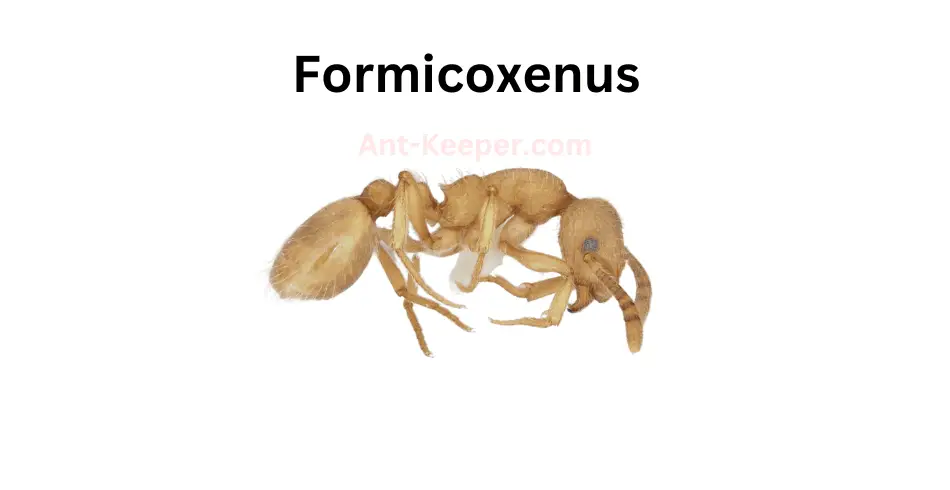
Formicoxenus is a genus of ants belonging to the subfamily Myrmicinae.
The ants in this genus are small in size, measuring between 1.5 to 3 millimeters in length.
They are known for their distinctive morphology, which includes a narrow waist and a large head with long mandibles.
Formicoxenus ants are typically found in forested areas, where they live in small colonies under rocks, logs, or in leaf litter.
They are known to be highly specialized, with each species having a specific host ant species that they parasitize.
The Formicoxenus ants are social parasites, meaning that they rely on their host ants for food and shelter.
The reproductive strategy of Formicoxenus ants is unique.
The queen ant will infiltrate the host colony and kill the resident queen.
She will then lay her eggs in the host colony, which will be raised by the host workers.
The Formicoxenus larvae will then feed on the host ant larvae and pupae, ensuring their survival.
Formicoxenus ants are important members of forest ecosystems, as they play a role in controlling the population of their host ants.
They are also important indicators of forest health, as their presence can indicate the presence of healthy forest ecosystems.
11) Harpagoxenus
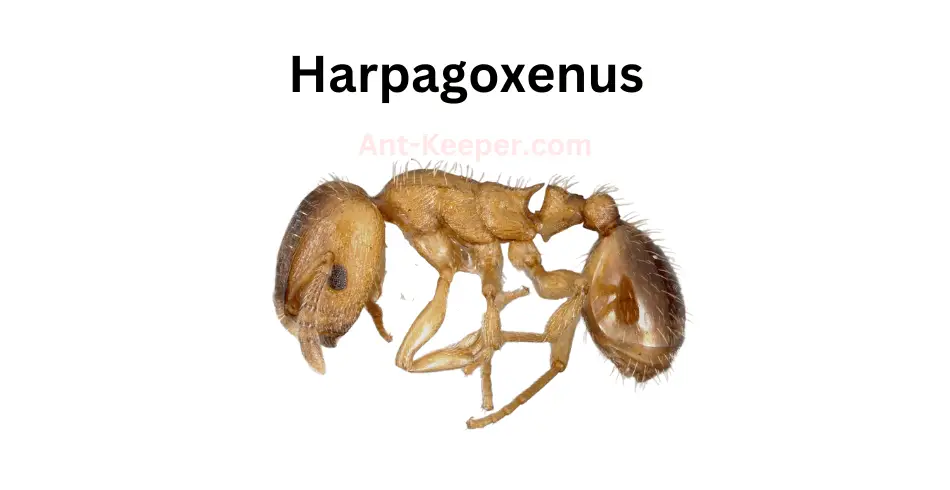
Harpagoxenus is a genus of ants belonging to the subfamily Myrmicinae.
The species Harpagoxenus can be identified by its small size, measuring only a few millimeters in length.
They have a dark brown to black coloration and a slender body shape.
Harpagoxenus ants are known for their unique social behavior.
They are considered to be social parasites, meaning they rely on other ant species to raise their young.
Harpagoxenus queens will invade the nests of other ant species and lay their eggs among the host colony's brood.
The Harpagoxenus larvae will then be fed and cared for by the host workers until they reach adulthood.
Once the Harpagoxenus workers emerge, they will begin to take over the host colony.
They will kill the host queen and force the remaining workers to care for their young.
The Harpagoxenus workers will also take over the food resources of the host colony, ensuring their own survival.
Harpagoxenus ants are found in a variety of habitats, including forests, grasslands, and deserts.
They are most commonly found in areas with high ant diversity, as they rely on other ant species for their survival.
Overall, Harpagoxenus ants are fascinating creatures with unique social behavior.
Their reliance on other ant species for survival makes them an important part of the ecosystem and highlights the complex interactions between different species in nature.
12) Crypt Ants, Hypoponera
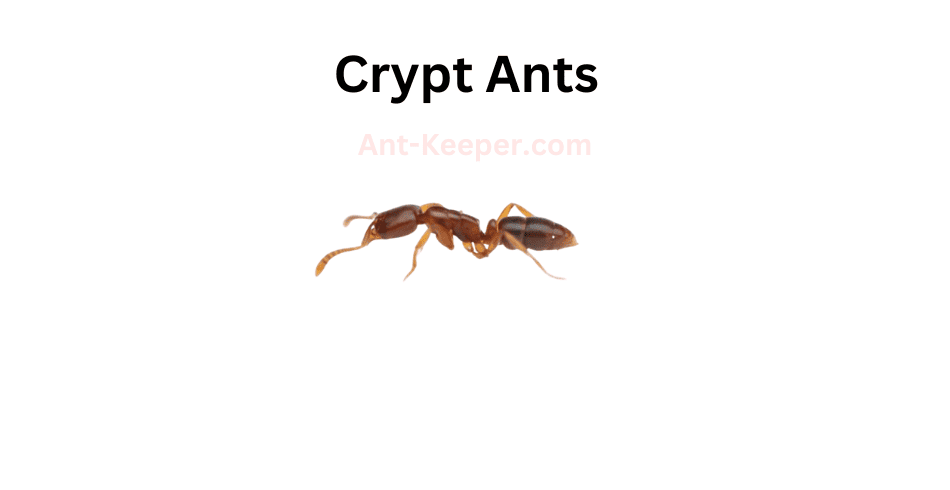
Crypt ants, also known as fungus-growing ants, are a group of ants that cultivate fungi for food.
They are found in various habitats, including forests, grasslands, and deserts.
Crypt ants are known for their unique nesting behavior, as they construct underground chambers to house their fungal gardens.
These ants have a symbiotic relationship with the fungi they cultivate.
The ants provide the fungi with a suitable environment for growth, while the fungi provide the ants with a source of food.
The ants also protect their fungal gardens from other insects and parasites.
Crypt ants are social insects, living in colonies that can range from a few dozen to several thousand individuals.
The colonies are organized into castes, with the queen being the largest and most important member.
The queen is responsible for laying eggs, while the workers are responsible for tending to the fungal gardens and caring for the young.
One interesting aspect of crypt ants is their ability to create "satellite" nests.
These nests are smaller chambers located near the main nest, and they serve as storage areas for food and as a place for the queen to lay eggs.
The satellite nests are connected to the main nest by underground tunnels, allowing the ants to move between them.
Overall, crypt ants are fascinating insects that have developed a unique way of obtaining food.
Their symbiotic relationship with fungi and their complex nesting behavior make them an important species to study in the field of entomology.
13) Moisture Ants, Lasius
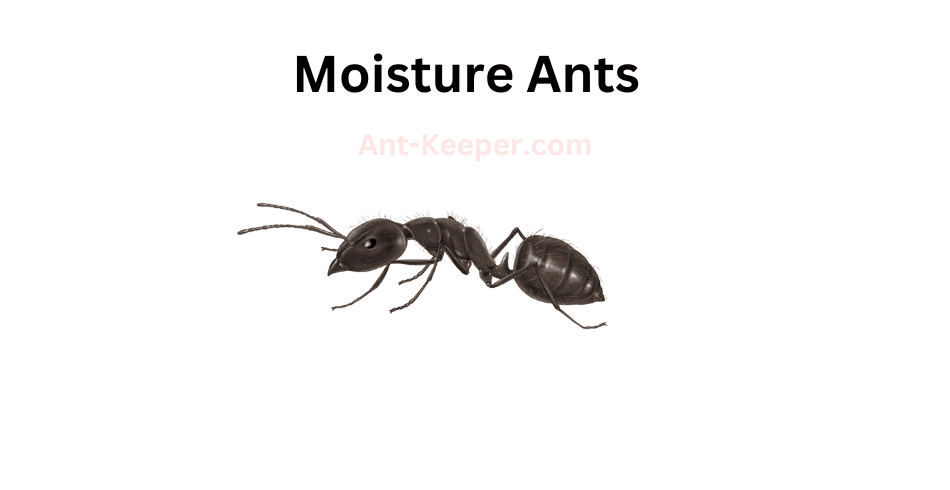
Moisture ants are a type of ant that is commonly found in damp environments.
They are known for their ability to thrive in areas with high levels of moisture, such as in rotting wood or in soil that is constantly moist.
These ants are typically small in size, measuring only a few millimeters in length, and are usually yellow or brown in color.
Moisture ants are social insects that live in colonies, with each colony consisting of a queen, workers, and soldiers.
The queen is responsible for laying eggs, while the workers and soldiers are responsible for maintaining the colony and protecting it from predators.
One of the unique characteristics of moisture ants is their ability to create satellite colonies.
These colonies are established in nearby locations and are connected to the main colony by a network of tunnels.
This allows the ants to expand their territory and increase their chances of survival.
Moisture ants are also known for their ability to control the moisture levels in their environment.
They do this by building intricate nests that are designed to regulate the humidity levels inside.
This is important for the survival of the colony, as too much moisture can lead to the growth of harmful fungi and bacteria.
Overall, moisture ants are fascinating creatures that have adapted to thrive in environments that would be inhospitable to many other species.
Their ability to control moisture levels and create satellite colonies makes them a formidable force in their ecosystem.
14) Leptothorax
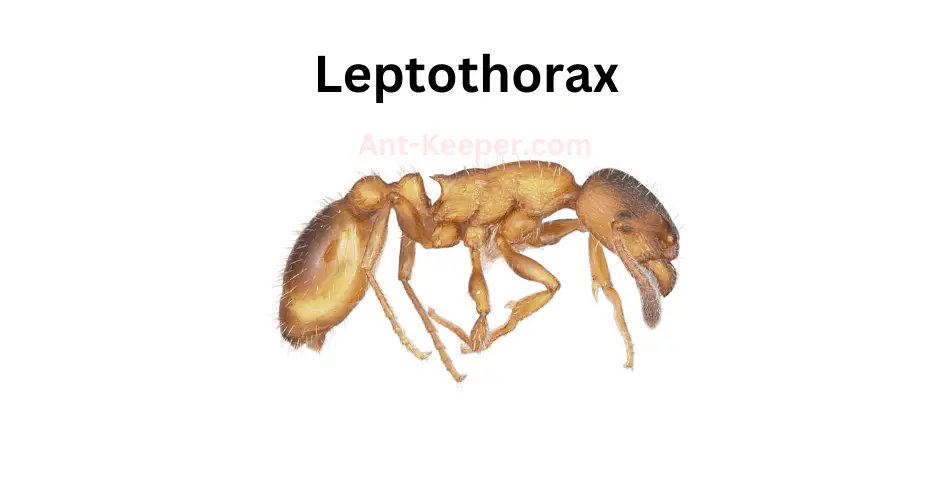
Leptothorax is a genus of ants that belongs to the family Formicidae.
These ants are small in size, measuring between 2 to 4 millimeters in length.
They are commonly found in forests, grasslands, and other natural habitats.
Leptothorax ants are known for their social behavior, as they live in colonies that can range from a few dozen to several hundred individuals.
These ants have a hierarchical social structure, with a queen ant at the top and worker ants at the bottom.
The queen ant is responsible for laying eggs, while the worker ants take care of the young, gather food, and defend the colony from predators.
One interesting feature of Leptothorax ants is their ability to form temporary colonies with other ant species.
This behavior is known as "temporary social parasitism," and it allows Leptothorax ants to benefit from the resources of other ant colonies without having to invest in their own colony infrastructure.
Leptothorax ants are also known for their ability to navigate through complex environments.
They use a combination of visual cues and chemical signals to find their way back to the colony after foraging for food.
Overall, Leptothorax ants are fascinating creatures that play an important role in their ecosystems.
Their social behavior and navigational abilities make them a subject of interest for scientists studying animal behavior and ecology.
15) Trailing Pharaoh And Timid Ants, Monomorium

The Trailing Pharaoh ant, also known as the Monomorium pharaonis, is a small, reddish-brown ant species that is commonly found in urban areas.
These ants are known for their ability to form large colonies, which can consist of thousands of individuals.
One interesting behavior of the Trailing Pharaoh ant is their tendency to trail behind other ants.
This behavior is thought to be a form of communication, as the trailing ants are able to follow the scent trail left by the leading ants.
This behavior is also used to locate food sources, as the trailing ants are able to follow the trail to the source of the food.
In contrast to the bold behavior of the Trailing Pharaoh ant, the Timid ant, also known as the Temnothorax species, is a much more cautious species.
These ants are small and brown, and are often found in wooded areas.
They are known for their timid behavior, and will often retreat into their nests when threatened.
Despite their timid nature, the Timid ant is still able to form large colonies.
They are also known for their ability to adapt to changing environments, and can be found in a variety of habitats, including forests, meadows, and even urban areas.
Overall, both the Trailing Pharaoh ant and the Timid ant are fascinating species that demonstrate unique behaviors and adaptations.
By studying these ants, scientists can gain a better understanding of the complex social behaviors and ecological roles of ants in their respective environments.
16) Mite-Eating Ants, Myrmecina
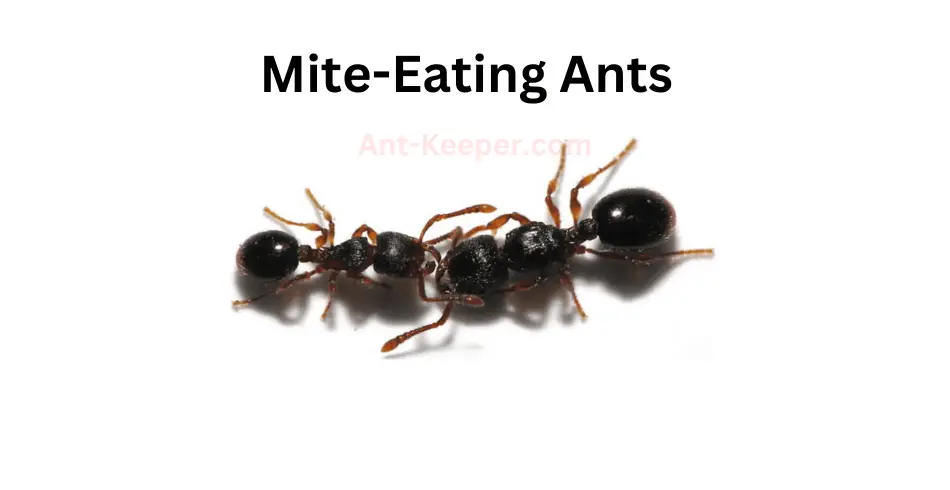
The Mite-Eating Ant, also known as the Pheidole megacephala, is a species of ant that is commonly found in tropical and subtropical regions around the world.
These ants are known for their unique feeding habits, as they primarily feed on mites and other small arthropods.
The Mite-Eating Ant is a relatively small ant, with workers measuring between 2-3mm in length.
They have a distinctive head shape, with a large and elongated head that is almost as wide as their thorax.
Their bodies are typically a reddish-brown color, with darker legs and antennae.
These ants are highly social, living in large colonies that can contain thousands of individuals.
The colonies are typically divided into two groups: workers and reproductive individuals.
The workers are responsible for foraging for food, caring for the young, and defending the colony, while the reproductive individuals are responsible for producing offspring.
One of the most interesting aspects of the Mite-Eating Ant is their feeding habits.
These ants are specialized predators, feeding almost exclusively on mites and other small arthropods.
They use their large mandibles to capture and kill their prey, and then carry it back to the colony to be consumed.
In addition to their unique feeding habits, the Mite-Eating Ant is also known for its ability to adapt to a wide range of environments.
They are able to thrive in both natural and urban environments, and can be found in a variety of habitats, including forests, grasslands, and even in homes and buildings.
Overall, the Mite-Eating Ant is a fascinating species of ant that has adapted to a unique niche in the ecosystem.
Their specialized feeding habits and ability to thrive in a variety of environments make them an important species to study and understand.
17) Furrowed Ants, Myrmica

Furrowed ants, also known as Pheidole ruginoda, are a species of ant that belong to the family Formicidae.
These ants are commonly found in various habitats such as forests, grasslands, and deserts.
They are known for their distinctive appearance, with a furrowed head and thorax, and a smooth and shiny abdomen.
Furrowed ants are social insects that live in colonies, which can range in size from a few hundred to several thousand individuals.
The colony is typically headed by a queen ant, whose primary role is to lay eggs.
The workers, which are sterile females, are responsible for foraging, nest maintenance, and caring for the young.
These ants are omnivorous, meaning they feed on both plant and animal matter.
Their diet consists of seeds, insects, and other small invertebrates.
They are also known to tend to aphids, which produce a sugary substance that the ants feed on.
Furrowed ants are known for their aggressive behavior, and will defend their colony fiercely against intruders.
They have been observed engaging in territorial battles with other ant species, and will even attack larger insects such as grasshoppers and beetles.
Overall, furrowed ants are an important part of many ecosystems, playing a crucial role in seed dispersal and soil aeration.
Their unique appearance and behavior make them a fascinating subject for study and observation.
18) Army Ants, Neivamyrmex
Army ants are a type of ant that belong to the subfamily Dorylinae.
They are known for their aggressive behavior and their ability to form large colonies that can contain up to several million individuals.
Army ants are found in tropical and subtropical regions around the world, and they play an important role in the ecosystems where they live.
One of the most distinctive features of army ants is their nomadic lifestyle.
Unlike other ants that build permanent nests, army ants are constantly on the move, searching for food and new nesting sites.
They are also known for their impressive hunting skills.
When they come across prey, they swarm over it in large numbers, overwhelming it with their sheer numbers and powerful jaws.
Army ants are also social insects, with a complex hierarchy that determines the roles of each individual in the colony.
The queen is the largest ant in the colony and is responsible for laying eggs.
The workers are responsible for foraging, caring for the young, and defending the colony.
The soldiers are larger and have stronger jaws, which they use to protect the colony from predators.
Despite their aggressive behavior, army ants are an important part of many ecosystems.
They help to control the populations of other insects and small animals, and they provide food for larger predators such as birds and mammals.
In some cultures, army ants are even used as a source of food for humans.
Overall, army ants are fascinating creatures that have adapted to life in some of the most challenging environments on Earth.
Their nomadic lifestyle, impressive hunting skills, and complex social structure make them one of the most interesting species of ants in the world.
19) Crazy Ants, Nylanderia

Crazy ants, also known as Nylanderia fulva, are a species of ant that belong to the family Formicidae.
They are small in size, measuring only about 2.2 to 3 mm in length, and are reddish-brown in color.
These ants are known for their erratic and unpredictable behavior, hence the name "crazy ants."
Crazy ants are native to South America, but have since spread to other parts of the world, including North America, Asia, and Australia.
They are highly adaptable and can thrive in a variety of environments, including urban areas, forests, and grasslands.
One of the most notable characteristics of crazy ants is their ability to form large colonies with multiple queens.
This allows them to quickly establish themselves in new areas and outcompete other ant species.
Crazy ants are also known for their aggressive behavior towards other insects and animals, including humans.
In addition to their aggressive behavior, crazy ants are also known for their ability to cause damage to electrical equipment.
They are attracted to electrical currents and can easily short-circuit electronics, causing damage and potentially starting fires.
Despite their small size, crazy ants are a formidable species that can have a significant impact on their environment.
As they continue to spread to new areas, it is important to monitor their behavior and take steps to control their populations in order to minimize their impact on ecosystems and human infrastructure.
20) Crazy Ants, Paratrechina

Crazy ants, also known as Nylanderia fulva, are a species of ant that belong to the family Formicidae.
They are small in size, measuring only about 2.2 to 3 mm in length, and are reddish-brown in color.
These ants are known for their erratic and unpredictable behavior, hence the name "crazy ants."
Crazy ants are native to South America, but have since spread to other parts of the world, including North America, Asia, and Australia.
They are highly adaptable and can thrive in a variety of environments, including urban areas, forests, and grasslands.
One of the most notable characteristics of crazy ants is their ability to form large colonies with multiple queens.
This allows them to quickly establish themselves in new areas and outcompete other ant species.
Crazy ants are also known for their aggressive behavior towards other insects and animals, including humans.
In addition to their aggressive behavior, crazy ants are also known for their ability to cause damage to electrical equipment.
They are attracted to electrical currents and can easily short-circuit electronics, causing damage and potentially starting fires.
Despite their small size, crazy ants are a formidable species that can have a significant impact on their environment.
As they continue to spread to new areas, it is important to monitor their behavior and take steps to control their populations in order to minimize their impact on ecosystems and human infrastructure.
21) Big Headed Ants, Pheidole

Big Headed Ants, also known as Pheidole megacephala, are a species of ant that belong to the family Formicidae.
These ants are known for their distinctive large heads, which are used for defense and communication within their colonies.
Big Headed Ants are typically found in tropical and subtropical regions, where they build their nests in soil, leaf litter, and other organic matter.
They are omnivorous, feeding on a variety of insects, seeds, and other small organisms.
One of the most interesting aspects of Big Headed Ants is their social behavior.
They live in large colonies, with a queen ant at the center of the hierarchy.
The queen is responsible for laying eggs, while the other ants in the colony perform various tasks such as foraging for food, caring for the young, and defending the colony from predators.
Big Headed Ants are also known for their ability to displace other ant species in their habitats.
They are aggressive and have been known to attack and kill other ants, as well as compete with them for resources.
Despite their aggressive behavior, Big Headed Ants are not considered a major pest species.
However, their ability to displace other ant species and their potential impact on native ecosystems make them an important species to study and monitor.
22) Typical American Harvester Ants, Pogonomyrmex
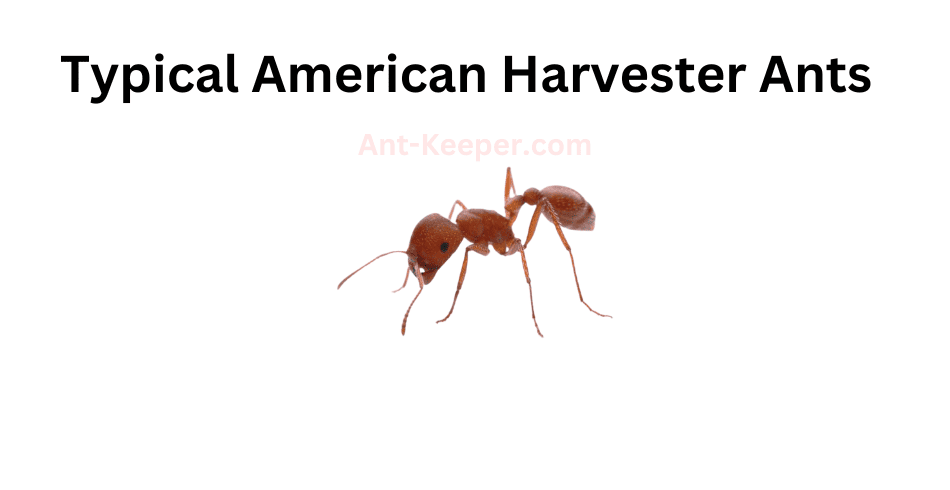
The typical American Harvester Ant (Pogonomyrmex spp.) is a species of ant that belongs to the family Formicidae.
These ants are commonly found in grasslands and deserts throughout North America.
They are known for their impressive ability to harvest and store seeds, which they use as a primary food source.
The American Harvester Ant is a medium-sized ant, with workers ranging in size from 4 to 8 mm in length.
They have a distinctive reddish-brown coloration and a large head with powerful mandibles.
These ants are highly social and live in large colonies, with a single queen responsible for laying eggs and producing new workers.
One of the most notable characteristics of the American Harvester Ant is their impressive seed harvesting behavior.
These ants use their powerful mandibles to cut and collect seeds from nearby plants, which they then carry back to their nest.
Once inside the nest, the ants store the seeds in underground chambers, where they can be accessed as needed.
In addition to their seed harvesting behavior, American Harvester Ants are also known for their aggressive defense of their nests.
These ants will fiercely defend their colony against any perceived threat, using their powerful mandibles to bite and sting intruders.
Overall, the American Harvester Ant is a fascinating species of ant with unique behaviors and adaptations that allow them to thrive in their native habitats.
Their impressive seed harvesting abilities and aggressive defense strategies make them an important part of many North American ecosystems.
23) Amazon Ants, Polyergus
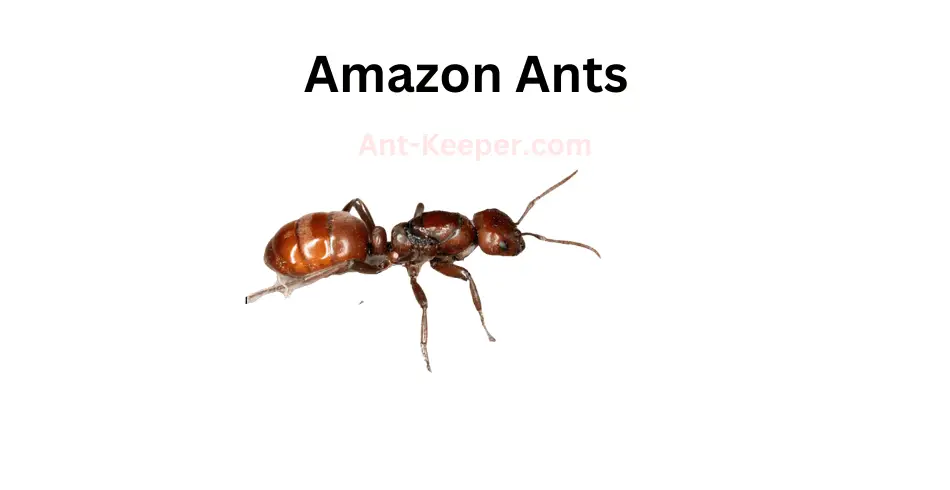
The Amazon Ant, also known as the Polyergus breviceps, is a species of ant that belongs to the Formicidae family.
These ants are known for their unique behavior of raiding other ant colonies and stealing their brood to raise as their own.
The Amazon Ants are typically black or dark brown in color and have a slender body with long legs.
They are relatively small in size, with workers measuring around 4-5 mm in length.
The queen ants are slightly larger, measuring around 7-8 mm in length.
These ants are social insects and live in large colonies that can consist of thousands of individuals.
The colonies are usually divided into different castes, including workers, soldiers, and reproductive ants.
The workers are responsible for foraging, caring for the brood, and maintaining the nest, while the soldiers defend the colony from predators.
One of the most interesting aspects of the Amazon Ants is their unique behavior of raiding other ant colonies.
They do this by sending out a group of specialized workers, known as raiders, to infiltrate the target colony.
The raiders then steal the brood of the target colony and bring it back to their own nest.
Once the stolen brood hatches, the Amazon Ants use it to increase their own workforce.
The Amazon Ants are also known for their symbiotic relationship with a species of butterfly known as the Maculinea rebeli.
The butterfly larvae feed on the brood of the Amazon Ants, but in return, they secrete a substance that makes the ants more aggressive and better at raiding other colonies.
Overall, the Amazon Ants are fascinating creatures with unique behaviors and adaptations that allow them to thrive in their environment.
24) Porthole Ants, Ponera
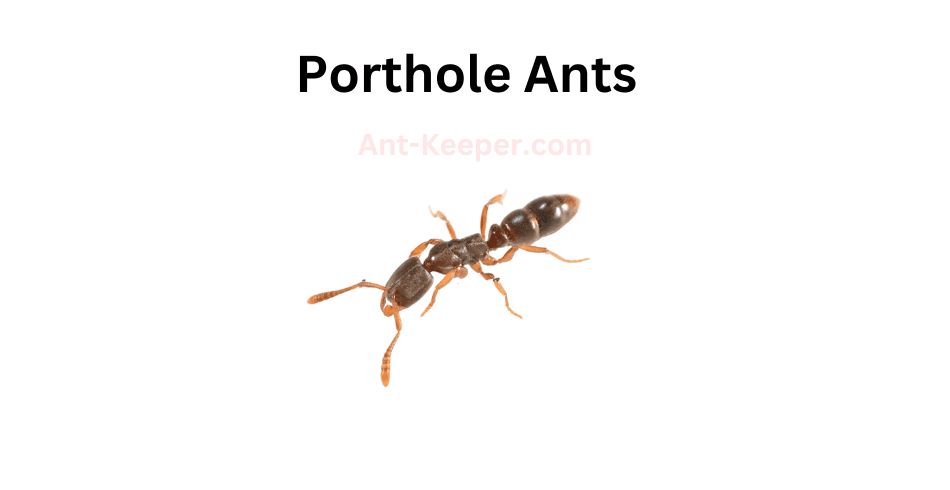
Porthole ants, also known as Temnothorax spp., are a genus of small ants that are commonly found in forested areas.
These ants are known for their unique nesting behavior, as they create their nests in small cavities or "portholes" in trees, rocks, or other natural structures.
Porthole ants are typically less than 5mm in length and have a dark brown or black coloration.
They are social insects and live in colonies that can range from a few dozen to several hundred individuals.
The colonies are typically led by a single queen, who is responsible for laying eggs and maintaining the colony's reproductive population.
One of the most interesting aspects of porthole ants is their nesting behavior.
Unlike many other ant species, porthole ants do not create large underground nests.
Instead, they seek out small cavities in natural structures and use them as their nesting sites.
These cavities can be as small as a few millimeters in diameter and are often located high up in trees or on rocky outcroppings.
Porthole ants are also known for their ability to adapt to changing environmental conditions.
They are able to quickly relocate their nests if their current nesting site becomes unsuitable due to factors such as flooding or predation.
This adaptability allows them to thrive in a variety of habitats, from temperate forests to arid deserts.
Overall, porthole ants are a fascinating and unique species of ant that have adapted to their environment in a variety of ways.
Their nesting behavior and adaptability make them an important species to study for understanding the ecology of forested areas.
25) Winter Ants, Prenolepis

Winter ants, also known as Formica exsectoides, are a species of ant that are commonly found in temperate regions.
These ants are known for their ability to survive harsh winter conditions, which is where they get their name from.
Winter ants are typically black or dark brown in color and can range in size from 4 to 8 millimeters in length.
They are social insects and live in large colonies that can contain thousands of individuals.
These colonies are typically located underground, where the ants construct elaborate tunnels and chambers.
One of the most interesting things about winter ants is their ability to survive the cold winter months.
Unlike many other ant species, winter ants do not hibernate during the winter.
Instead, they have developed a number of adaptations that allow them to survive in the cold.
One of these adaptations is the ability to regulate their body temperature.
Winter ants are able to generate heat by shivering their muscles, which allows them to maintain a temperature of around 25 degrees Celsius even when the outside temperature drops below freezing.
Winter ants also have a unique diet that helps them survive the winter.
They feed on the honeydew produced by aphids, which is a sugary substance that provides them with the energy they need to survive.
Overall, winter ants are a fascinating species of ant that have adapted to survive in some of the harshest conditions on earth.
Their ability to regulate their body temperature and feed on a unique diet make them a truly remarkable species.
26) Hairy Curltail Ants, Proceratium
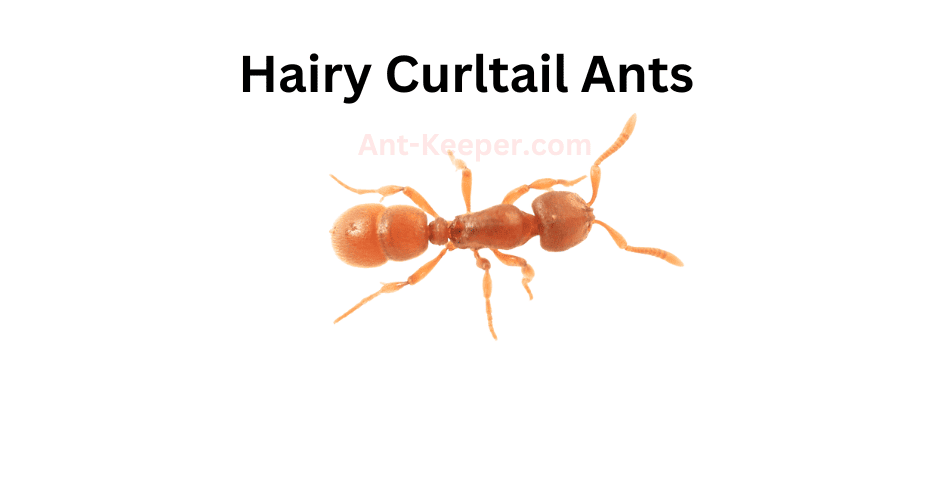
The Hairy Curltail Ant (Camponotus pilicornis) is a species of ant belonging to the genus Camponotus.
These ants are known for their distinctive hairy appearance, which covers their entire body.
The hairs on their body are long and curly, giving them a unique and striking appearance.
Hairy Curltail Ants are typically found in forested areas, where they build their nests in dead wood or under rocks.
They are known to be highly territorial and will aggressively defend their nests against intruders.
These ants are also known to be omnivorous, feeding on a variety of food sources including insects, nectar, and honeydew.
The Hairy Curltail Ant is a relatively large ant species, with workers measuring between 6-12mm in length.
The queen ant is even larger, measuring up to 15mm in length.
These ants are also known for their strong mandibles, which they use to defend their nests and capture prey.
One interesting aspect of the Hairy Curltail Ant is their ability to communicate with each other through the use of pheromones.
These chemical signals are used to mark trails, identify nestmates, and coordinate foraging activities.
Overall, the Hairy Curltail Ant is a fascinating species of ant with a unique appearance and interesting behaviors.
Their presence in forested areas can have important ecological implications, as they play a role in the ecosystem as both predators and scavengers.
27) Protomognathus
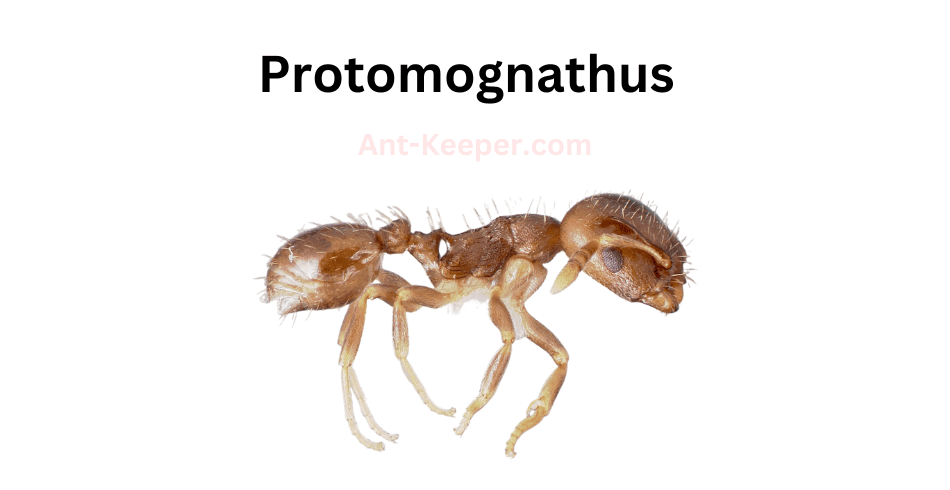
Protomognathus is a genus of ants belonging to the family Formicidae.
The ants in this genus are known for their aggressive behavior and are commonly found in tropical and subtropical regions.
The species Protomognathus americanus is one of the most well-known species in this genus.
Protomognathus ants are relatively small in size, with workers measuring between 2 and 5 millimeters in length.
They are typically reddish-brown in color and have a distinctive mandible shape that is used for capturing prey and defending their colony.
These ants are known for their predatory behavior and are often found hunting other insects and arthropods.
They are also known to scavenge for food and will consume a variety of organic matter, including dead insects and plant material.
Protomognathus ants are social insects and live in colonies that can range in size from a few dozen individuals to several thousand.
The colony is typically led by a queen ant, who is responsible for laying eggs and maintaining the overall health of the colony.
Overall, Protomognathus ants are fascinating creatures that play an important role in their ecosystems.
While they may be aggressive and predatory, they are also an important food source for many other animals and help to control populations of other insects and arthropods.
28) Fire Ants, Solenopsis
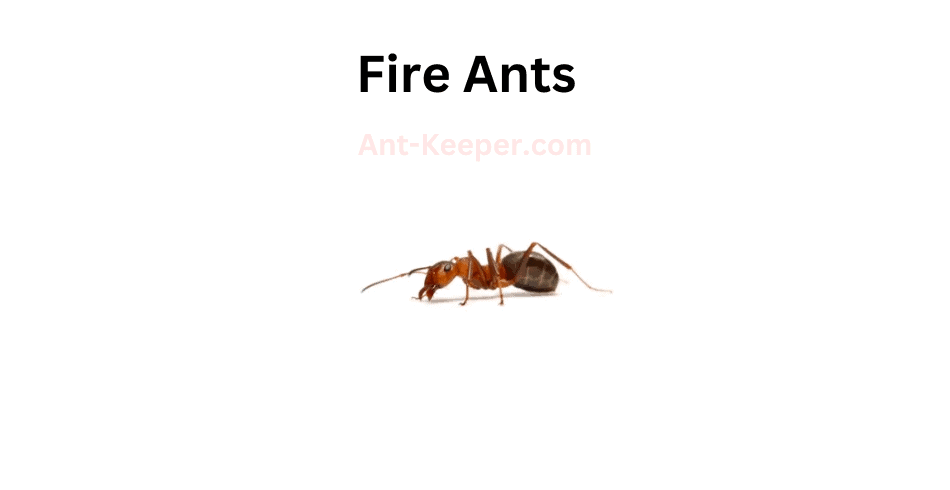
Fire ants are a type of ant that belongs to the Solenopsis genus.
They are known for their reddish-brown color and their aggressive behavior.
Fire ants are social insects that live in colonies, which can range in size from a few hundred to several thousand individuals.
Fire ants are omnivorous and feed on a variety of foods, including insects, seeds, and other small animals.
They are also known to scavenge for food and will often invade other ant colonies to steal their resources.
One of the most distinctive features of fire ants is their ability to sting.
They have a stinger located at the end of their abdomen, which they use to inject venom into their prey or enemies.
Fire ant stings can be painful and can cause an allergic reaction in some people.
Fire ants are also known for their ability to build large mounds, which can reach heights of up to 18 inches.
These mounds are made of soil and are used as a nesting site for the colony.
Fire ants are considered to be an invasive species in many parts of the world, as they can cause damage to crops and wildlife.
They are also a nuisance to humans, as their stings can be painful and their mounds can be unsightly.
Overall, fire ants are fascinating insects that have adapted to thrive in a variety of environments.
While they can be a nuisance, they are an important part of the ecosystem and play a vital role in controlling insect populations.
29) Leaf-Litter Ants, Stenamma

Leaf-litter ants are a group of ants that are commonly found in forested areas around the world.
They are known for their ability to live and forage in the leaf litter layer of the forest floor, where they play an important role in nutrient cycling and soil health.
Leaf-litter ants are typically small in size, ranging from 1-5mm in length.
They are often reddish-brown or black in color, and have a slender, elongated body shape.
These ants are social insects, living in colonies that can range in size from a few dozen to several thousand individuals.
One of the key characteristics of leaf-litter ants is their ability to forage for food in the leaf litter layer.
They are known to feed on a variety of organic matter, including dead insects, fungi, and plant material.
Leaf-litter ants are also important decomposers, breaking down organic matter and returning nutrients to the soil.
In addition to their role in nutrient cycling, leaf-litter ants also play an important role in the ecosystem as prey for other animals.
They are a food source for a variety of predators, including birds, reptiles, and other insects.
Overall, leaf-litter ants are an important and fascinating group of insects that play a critical role in maintaining the health and functioning of forest ecosystems around the world.
30) Vampire Ants, Stigmatomma
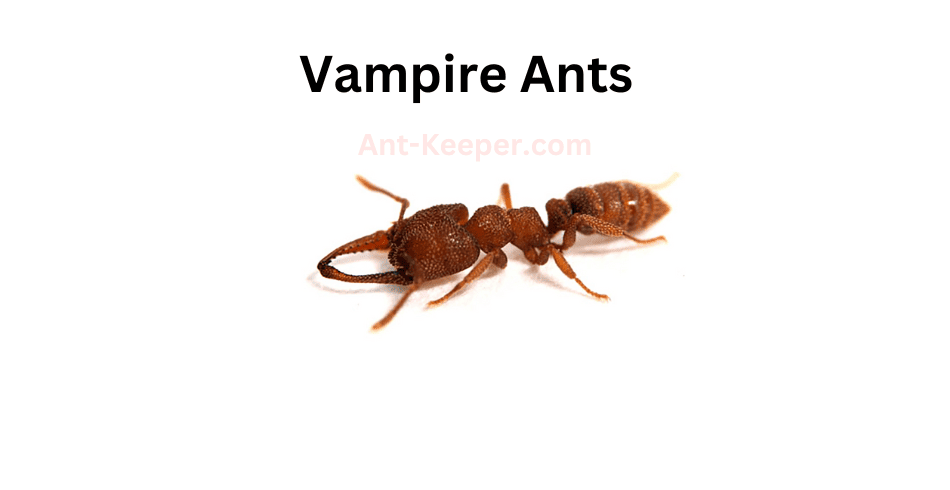
Vampire ants, also known as blood-sucking ants, are a species of ants that feed on the blood of other insects.
These ants are known for their unique feeding behavior, which involves biting into the exoskeleton of their prey and then sucking out their blood.
Vampire ants are typically found in tropical and subtropical regions, where they live in colonies of up to several thousand individuals.
They are known for their aggressive behavior and will attack other insects, including larger prey such as grasshoppers and caterpillars.
One of the most interesting aspects of vampire ants is their ability to adapt to their environment.
In some cases, these ants have been known to feed on the blood of their own colony members when other sources of food are scarce.
Vampire ants are also known for their unique physical characteristics.
They have long, curved mandibles that are used to bite into the exoskeleton of their prey.
They also have specialized mouthparts that allow them to suck out the blood of their victims.
Despite their aggressive behavior and blood-sucking tendencies, vampire ants play an important role in their ecosystem.
They help to control the populations of other insects and contribute to the overall balance of their environment.
Overall, vampire ants are a fascinating species of ants that have adapted to their environment in unique and interesting ways.
Their behavior and physical characteristics make them a subject of interest for scientists and nature enthusiasts alike.
31) Miniature Trap-Jaw Ants, Strumigenys
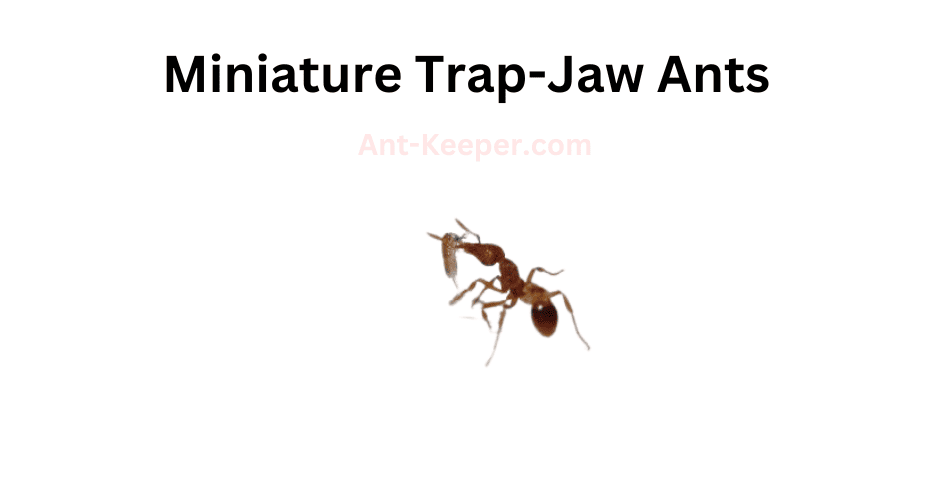
The Miniature Trap-Jaw Ants, scientifically known as Odontomachus sp., are a species of ants that belong to the family Formicidae.
These ants are known for their unique and powerful mandibles, which they use to capture prey and defend their colonies.
The Miniature Trap-Jaw Ants are relatively small in size, measuring only a few millimeters in length.
They have a dark brown or black coloration and a slender body shape.
Their most distinctive feature is their mandibles, which are elongated and can snap shut with incredible force.
These mandibles are used to capture prey, crush seeds, and defend the colony against predators.
The Miniature Trap-Jaw Ants are found in a variety of habitats, including forests, grasslands, and deserts.
They are known to be active during the day and are often seen foraging for food.
These ants are omnivorous and feed on a variety of food sources, including insects, nectar, and seeds.
The Miniature Trap-Jaw Ants are social insects and live in colonies that can range in size from a few dozen to several thousand individuals.
The colony is typically led by a queen, who is responsible for laying eggs and maintaining the colony's population.
The workers are responsible for foraging, caring for the young, and defending the colony.
Overall, the Miniature Trap-Jaw Ants are fascinating insects that have evolved unique adaptations to survive in their environment.
Their powerful mandibles and social behavior make them an important part of many ecosystems.
32) Tapinoma

Tapinoma is a genus of ants that belongs to the family Formicidae.
The species Tapinoma is a small ant that measures about 2-3 mm in length.
They are commonly found in urban and suburban areas, and are known to invade homes and buildings in search of food and shelter.
Tapinoma ants are light brown in color and have a slender body with long legs.
They have a distinctively shaped head that is wider than their thorax, and they possess a pair of antennae that are bent at a right angle.
These ants are known for their ability to form large colonies, which can consist of thousands of individuals.
Tapinoma ants are omnivorous and feed on a variety of food sources, including insects, nectar, and honeydew.
They are also known to scavenge for food in garbage cans and other waste areas.
These ants are attracted to sweet and sugary substances, and will often invade kitchens and pantries in search of food.
Tapinoma ants are not known to be aggressive towards humans, but they can become a nuisance when they invade homes and buildings.
They are known to build their nests in wall voids, under floors, and in other hidden areas.
If left unchecked, these ants can cause damage to structures and can contaminate food sources.
Overall, Tapinoma ants are a common pest in many parts of the world.
While they are not harmful to humans, they can be a nuisance when they invade homes and buildings.
Proper pest control measures can help to prevent infestations and keep these ants at bay.
33) Slave-Making Ants, Temnothorax
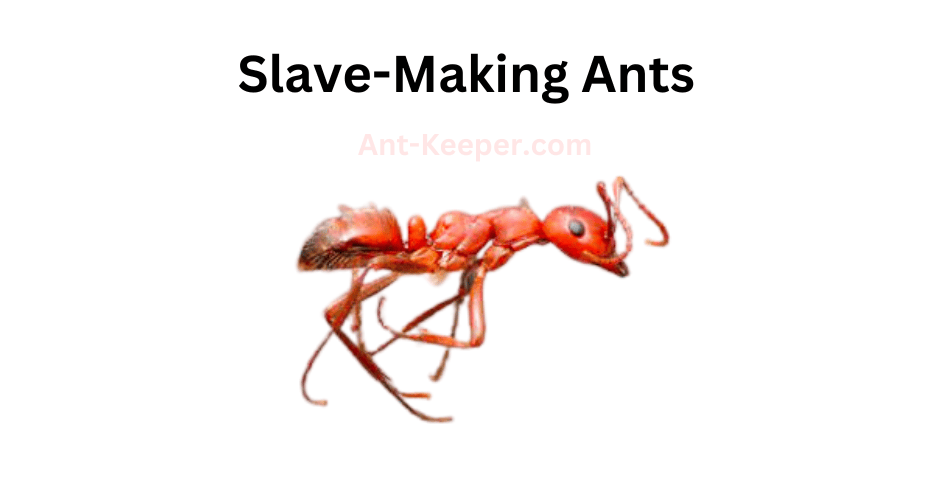
The Slave-Making Ants, also known as Dulosis ants, are a group of social insects that engage in a unique behavior of raiding and enslaving other ant colonies.
These ants belong to the subfamily Formicinae and are found in various parts of the world.
The Slave-Making Ants have a complex social structure, with a queen, workers, and soldiers.
The queen is responsible for laying eggs, while the workers and soldiers carry out various tasks such as foraging, nest building, and defense.
However, unlike other ant species, the Slave-Making Ants do not rely solely on their own colony for survival.
Instead, these ants raid nearby colonies of other ant species, using their superior strength and numbers to overpower the defenders.
The Slave-Making Ants then carry off the pupae of the conquered colony back to their own nest.
Once the pupae hatch, they are raised by the Slave-Making Ants and forced to work as slaves for the colony.
The Slave-Making Ants have evolved a number of adaptations to facilitate their slave-raiding behavior.
For example, they have a highly developed sense of smell, which allows them to locate and target specific ant colonies.
They also have strong mandibles and powerful stingers, which they use to subdue their prey.
Despite their aggressive behavior, the Slave-Making Ants play an important role in their ecosystem.
By raiding other ant colonies, they help to control the population of competing ant species.
Additionally, the enslaved ants provide a source of food and labor for the Slave-Making Ants, allowing them to thrive in environments where resources are scarce.
Overall, the Slave-Making Ants are a fascinating and unique species of ant, with a complex social structure and a highly specialized behavior.
While their slave-raiding behavior may seem cruel, it is an important part of their survival strategy and has helped them to thrive in a variety of environments.
34) Pavement Ants, Tetramorium
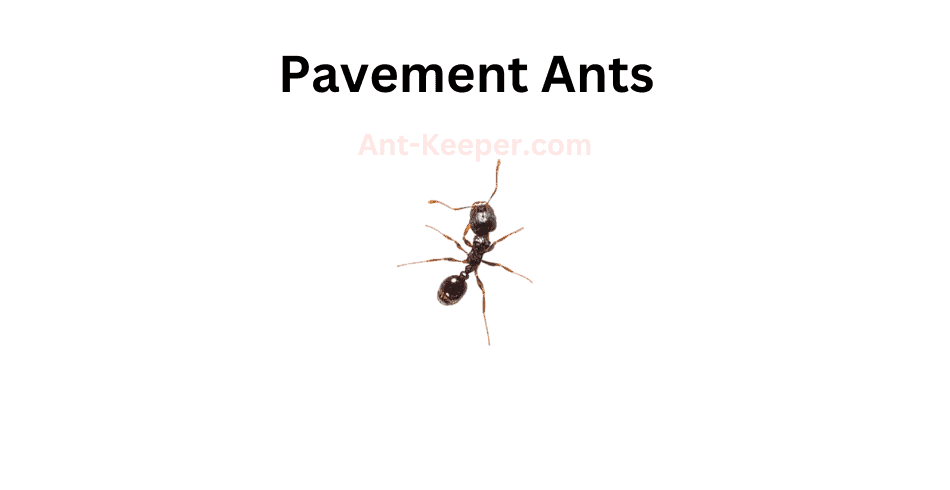
Pavement ants, also known as Tetramorium caespitum, are a species of ant that belong to the family Formicidae.
These ants are commonly found in urban and suburban areas, where they build their nests in cracks and crevices in pavement, sidewalks, and buildings.
Pavement ants are small in size, measuring between 2.5 to 4 mm in length.
They are typically dark brown or black in color, with lighter colored legs and antennae.
These ants are known for their aggressive behavior and will defend their nests fiercely against intruders.
Pavement ants are omnivorous, feeding on a variety of foods including insects, seeds, and sweet substances such as honeydew and nectar.
They are also known to scavenge for food in garbage cans and other waste areas.
Pavement ants are social insects, living in colonies that can range in size from a few hundred to several thousand individuals.
The colony is typically led by a queen ant, who is responsible for laying eggs and maintaining the colony.
Pavement ants are considered a nuisance pest, as they can invade homes and buildings in search of food and shelter.
They are also known to cause damage to pavement and other structures by excavating soil and creating tunnels.
Overall, pavement ants are a common and adaptable species of ant that play an important role in urban ecosystems.
While they may be a nuisance to humans, they are an important food source for many other animals and help to maintain the balance of the ecosystem.
35) Trachymyrmex
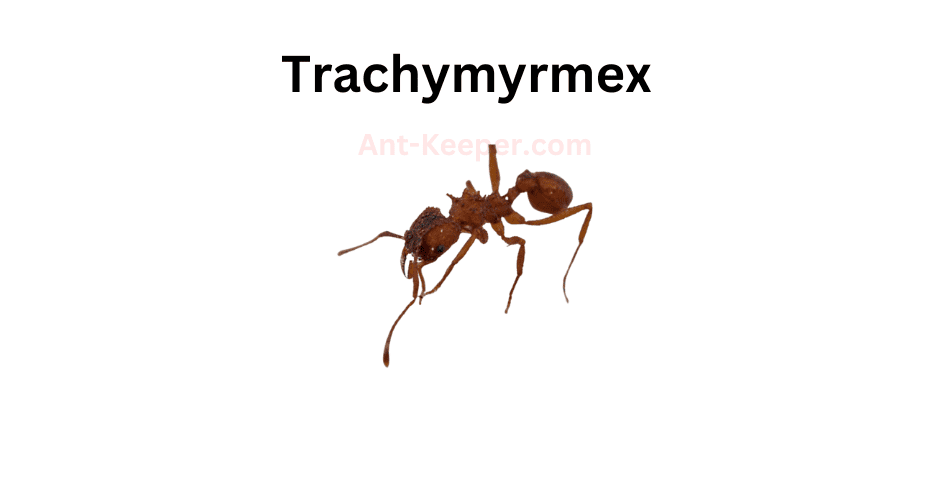
Trachymyrmex is a genus of ants that belongs to the subfamily Myrmicinae.
These ants are known for their fungus-growing behavior, which involves cultivating a specific type of fungus in their nests as a food source.
Trachymyrmex ants are small in size, typically measuring between 2-5mm in length.
They have a distinctive appearance, with a dark brown or black body and long, slender legs.
Trachymyrmex ants are highly social insects, living in large colonies that can contain thousands of individuals.
The colonies are organized into castes, with specialized workers responsible for different tasks such as foraging, nest maintenance, and caring for the young.
The queen ant is the largest member of the colony and is responsible for laying eggs.
One of the most interesting aspects of Trachymyrmex ants is their relationship with the fungus they cultivate.
The ants collect plant material, which they bring back to the nest and use to grow the fungus.
The fungus, in turn, provides the ants with a nutritious food source.
The ants also have a complex system of waste management, which involves removing waste from the nest and depositing it in specific areas where it can be used to fertilize the fungus.
Trachymyrmex ants are found in a variety of habitats, including forests, grasslands, and deserts.
They are important members of their ecosystems, playing a role in nutrient cycling and soil health.
However, like many other ant species, Trachymyrmex ants can also be considered pests, as they can damage crops and invade homes.
Overall, Trachymyrmex ants are fascinating creatures with complex social behaviors and a unique relationship with the fungus they cultivate.
Their importance in their ecosystems and potential as pests make them an important subject of study for scientists and pest control professionals alike.
36) Tawny Collared Ants, Aphaenogaster Fulva
Tawny collared ants, also known as Pseudomyrmex gracilis, are a species of arboreal ants that belong to the family Formicidae.
These ants are found in tropical and subtropical regions around the world, and are known for their distinctive tawny-colored collars that encircle their thoraxes.
Tawny collared ants are relatively small, with workers measuring between 3-5mm in length.
They are highly social insects, living in large colonies that can contain thousands of individuals.
These ants are known for their aggressive behavior, and will readily defend their nests against intruders.
One of the most interesting aspects of tawny collared ants is their relationship with certain species of acacia trees.
These ants have a mutualistic relationship with acacias, in which the ants provide protection for the tree in exchange for food and shelter.
The ants live in the hollow thorns of the acacia tree, and will aggressively defend the tree against herbivores and other insects.
In return, the tree provides the ants with nectar and protein-rich Beltian bodies, which are specialized structures that grow on the tips of the tree's leaves.
Tawny collared ants are also known for their ability to sting, which can be painful for humans.
However, their stings are not typically dangerous, and are only used as a last resort when the ants feel threatened.
Overall, tawny collared ants are fascinating insects that play an important role in their ecosystems.
Their mutualistic relationship with acacia trees is just one example of the complex interactions that occur between different species in the natural world.
37) Notched Collared Ants, Aphaenogaster Lamellidens
The Notched Collared Ants (Formica subsericea) are a species of ant belonging to the Formicidae family.
They are commonly found in temperate regions and are known for their distinctive notched collars, which are present on the thorax of the worker ants.
The Notched Collared Ants are social insects and live in colonies that can range in size from a few hundred to several thousand individuals.
The colonies are typically located in soil or leaf litter, and the ants construct intricate networks of tunnels and chambers to house their brood and store food.
Worker ants of the Notched Collared Ants are polymorphic, meaning that they come in different sizes and perform different tasks within the colony.
The smallest workers, known as minors, are responsible for foraging for food and caring for the brood.
The larger workers, known as majors, are responsible for defending the colony and can have powerful mandibles that they use to crush prey and deter predators.
Notched Collared Ants are omnivorous and feed on a variety of food sources, including insects, nectar, and honeydew.
They are also known to tend to aphids and other insects that produce honeydew, which the ants collect and consume.
The Notched Collared Ants are an important part of many ecosystems, as they help to control populations of other insects and contribute to soil health through their tunneling activities.
However, they can also be considered pests in some situations, as they can damage crops and invade homes and other structures.
Overall, the Notched Collared Ants are a fascinating species of ant that play an important role in many ecosystems.
Their distinctive notched collars and complex social behaviors make them a subject of interest for scientists and nature enthusiasts alike.
38) Marys Collared Ants, Aphaenogaster Mariae
Mary's Collared Ants, also known as Pheidole maryae, are a species of ant belonging to the family Formicidae.
These ants are typically small in size, measuring between 2.5 to 3.5 millimeters in length.
They are characterized by their distinctive collar-like structure on their mesosoma, which is the middle section of their body.
Mary's Collared Ants are known to be highly territorial and aggressive towards other ant species.
They are also known to be omnivorous, feeding on a variety of food sources including insects, seeds, and nectar.
These ants are typically found in forested areas, where they build their nests in soil or leaf litter.
One interesting aspect of Mary's Collared Ants is their reproductive strategy.
They have a unique system of reproduction called haplodiploidy, where females are diploid and males are haploid.
This means that females have two sets of chromosomes, while males have only one set.
This system allows for the production of genetically diverse offspring, which can increase the chances of survival in changing environments.
Overall, Mary's Collared Ants are a fascinating species of ant with unique characteristics and behaviors.
Their territorial nature and reproductive strategy make them an important species to study in the field of entomology.
39) Winnow Ants, Aphaenogaster Rudis
The Winnow Ant, also known as the Acanthomyops interjectus, is a species of ant that belongs to the Formicidae family.
These ants are commonly found in grasslands and open areas, where they build their nests in the soil.
The Winnow Ant is known for its unique behavior of winnowing, which involves the sorting and removal of debris from their nests.
The Winnow Ant is a small ant, measuring around 3-4 mm in length.
They have a dark brown or black coloration, with a shiny and smooth exoskeleton.
The workers of this species are polymorphic, meaning they come in different sizes.
The larger workers are responsible for foraging and defending the nest, while the smaller workers take care of the brood and tend to the queen.
One of the most interesting behaviors of the Winnow Ant is their winnowing behavior.
This involves the removal of debris and unwanted materials from their nests, such as dead insects, soil particles, and other debris.
The ants use their mandibles to pick up the debris and carry it outside the nest, where it is deposited in a pile.
This behavior helps to keep the nest clean and free from unwanted materials.
The Winnow Ant is an omnivorous species, feeding on a variety of food sources.
They primarily feed on honeydew produced by aphids and other insects, as well as small insects and other arthropods.
They are also known to scavenge on dead insects and other organic matter.
The Winnow Ant is a social species, living in colonies that can range in size from a few hundred to several thousand individuals.
The colony is headed by a single queen, who is responsible for laying eggs and producing new workers.
The workers of the colony work together to maintain the nest, care for the brood, and defend the colony from predators and other threats.
Overall, the Winnow Ant is a fascinating species of ant that exhibits unique behaviors and adaptations.
Their winnowing behavior and social structure make them an important part of many ecosystems, and they play a vital role in maintaining the balance of these ecosystems.
40) Tennessee Collared Ants, Aphaenogaster Tennesseensis
The Tennessee Collared Ants (Formica angustipila) are a species of ants belonging to the Formicidae family.
These ants are known for their distinct collar-like marking on their thorax, which is a distinguishing feature of the species.
The workers of this species are typically small, measuring around 4-5 mm in length, and are reddish-brown in color.
Tennessee Collared Ants are known to be highly territorial and aggressive towards other ant species.
They are also known to be omnivorous, feeding on a variety of food sources including insects, nectar, and honeydew.
These ants are known to be active during the day and are often seen foraging for food in large groups.
The Tennessee Collared Ants are known to build large underground nests, which can house thousands of individuals.
These nests are typically located in soil or leaf litter and are often marked by a small mound of soil or debris.
The queen of this species is known to be the largest individual in the colony and is responsible for laying eggs and maintaining the colony.
Overall, the Tennessee Collared Ants are an important species in their ecosystem, playing a crucial role in soil health and nutrient cycling.
They are also an important food source for many other animals, including birds and mammals.
41) Treats Winnow Ants, Aphaenogaster Treatae
Treat's Winnow Ants, also known as Aphaenogaster treatae, are a species of ant that belong to the family Formicidae.
These ants are typically found in dry, sandy habitats such as deserts and grasslands.
They are known for their unique behavior of winnowing, which involves using their mandibles to sort through soil and debris in search of food.
Treat's Winnow Ants are small in size, measuring between 3-5mm in length.
They have a dark brown or black coloration and a slender body shape.
These ants are known for their strong mandibles, which they use to break down and carry food back to their nest.
One of the most interesting aspects of Treat's Winnow Ants is their winnowing behavior.
This involves using their mandibles to sort through soil and debris in search of food.
The ants will pick up small particles of soil and debris and sift through them, discarding any unwanted material and keeping the food items.
This behavior is thought to be an adaptation to their dry, sandy habitat, where food resources may be scarce.
Treat's Winnow Ants are also known for their social behavior.
They live in colonies that can range in size from a few dozen to several thousand individuals.
The colony is typically led by a queen ant, who is responsible for laying eggs and maintaining the colony.
The other ants in the colony are divided into different castes, including workers, soldiers, and reproductive ants.
Overall, Treat's Winnow Ants are a fascinating species of ant that have adapted to their unique habitat through their winnowing behavior.
Their social behavior and strong mandibles make them an important part of their ecosystem.
42) Hairless Rover Ants, Brachymyrmex Depilis
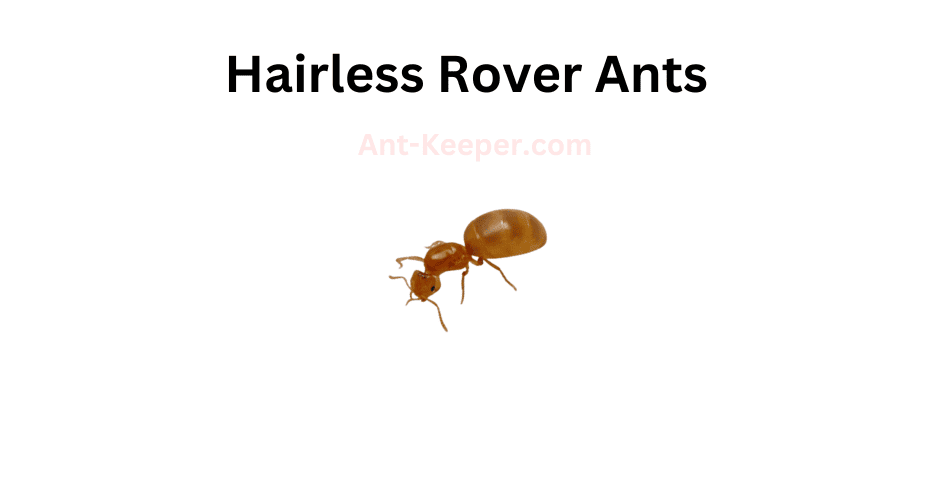
The Hairless Rover Ant, also known as Brachymyrmex patagonicus, is a small ant species that belongs to the family Formicidae.
These ants are typically found in urban and suburban areas, and are known for their hairless bodies and ability to quickly move from one location to another.
The Hairless Rover Ants are typically light brown in color and measure between 1.5 and 2.5 mm in length.
They have a distinct head and thorax, with a narrow waist and a bulbous abdomen.
Unlike other ant species, the Hairless Rover Ants lack the typical hairs that cover the body of most ants.
These ants are known for their ability to quickly move from one location to another, which is why they are often found in urban and suburban areas.
They are typically found in gardens, parks, and other areas where there is a lot of vegetation.
They are also known to invade homes and buildings, where they can be a nuisance to homeowners.
The Hairless Rover Ants are omnivorous, which means that they eat both plant and animal matter.
They are known to feed on insects, fruits, and other plant material.
They are also known to scavenge for food, and will often invade other ant colonies to steal their food.
The Hairless Rover Ants are social insects, and live in large colonies that can contain thousands of individuals.
They are known for their ability to quickly adapt to new environments, which is why they are able to thrive in urban and suburban areas.
Overall, the Hairless Rover Ants are an interesting and unique species of ant that are well adapted to living in urban and suburban environments.
While they can be a nuisance to homeowners, they play an important role in the ecosystem by helping to control insect populations and by serving as a food source for other animals.
43) Chestnut Carpenter Ants, Camponotus Castaneus
The Chestnut Carpenter Ant, also known as Camponotus castaneus, is a species of ant belonging to the family Formicidae.
These ants are commonly found in forests and woodlands, where they build their nests in dead or decaying wood.
The Chestnut Carpenter Ant is a large ant, with workers ranging in size from 6 to 13 mm in length.
They have a dark brown or black body, with reddish-brown legs and antennae.
The workers are polymorphic, meaning that they come in different sizes and perform different tasks within the colony.
These ants are known for their ability to excavate wood, which they use to build their nests.
They do not eat the wood, but instead feed on honeydew produced by aphids and other insects.
The Chestnut Carpenter Ant is also known to prey on other insects, such as termites and caterpillars.
The colony of Chestnut Carpenter Ants is typically headed by a queen, who is responsible for laying eggs.
The workers take care of the queen and her brood, as well as foraging for food and defending the colony from predators.
Chestnut Carpenter Ants play an important role in forest ecosystems, as they help to break down dead wood and recycle nutrients back into the soil.
However, they can also cause damage to wooden structures, such as homes and buildings, if they build their nests inside.
Overall, the Chestnut Carpenter Ant is a fascinating species of ant that has adapted to living in forest environments.
Their ability to excavate wood and prey on other insects makes them an important part of the ecosystem, while their large size and unique appearance make them a fascinating subject for study.
44) Carpenter And Sugar Ants, Camponotus Decipiens

Carpenter ants and sugar ants are two common species of ants found in many regions of the world.
Carpenter ants are known for their ability to excavate wood and create nests within it.
They are typically larger in size than sugar ants and have a black or dark brown coloration.
Carpenter ants are also known for their strong mandibles, which they use to chew through wood and other materials.
Sugar ants, on the other hand, are smaller in size and have a yellow or brown coloration.
They are named for their preference for sugary foods and are often found in kitchens and other areas where food is stored.
Sugar ants are also known for their ability to form large colonies, with thousands of individual ants working together to gather food and care for their young.
Both carpenter ants and sugar ants play important roles in their ecosystems.
Carpenter ants help to break down dead wood and other plant material, which helps to recycle nutrients back into the soil.
Sugar ants help to disperse seeds and pollinate plants, which helps to maintain healthy ecosystems.
However, both species can also be pests when they invade human homes and buildings.
Carpenter ants can cause damage to wooden structures, while sugar ants can contaminate food and be a nuisance to homeowners.
It is important to take steps to prevent ant infestations and to control them if they do occur, in order to protect both human health and the health of the environment.
45) Smaller Carpenter Ants, Camponotus Nearcticus
The Smaller Carpenter Ants, also known as Camponotus spp., are a species of ants that belong to the genus Camponotus.
They are commonly found in various habitats, including forests, grasslands, and urban areas.
These ants are known for their ability to excavate wood and create nests inside it, which is why they are called Carpenter Ants.
The Smaller Carpenter Ants are relatively small in size, measuring between 6 and 12 millimeters in length.
They have a black or dark brown coloration and a smooth, shiny exoskeleton.
Their antennae are elbowed and have 12 segments, while their mandibles are strong and curved, allowing them to chew through wood.
These ants are social insects that live in colonies, which can range in size from a few dozen to several thousand individuals.
The colony is usually headed by a queen, whose primary role is to lay eggs.
The workers, which are sterile females, are responsible for foraging, nest maintenance, and caring for the young.
The Smaller Carpenter Ants are omnivorous, feeding on a variety of food sources, including insects, nectar, and honeydew.
They are also known to scavenge for food in human dwellings, making them a nuisance pest.
In terms of their ecological role, the Smaller Carpenter Ants play an important role in the ecosystem by helping to decompose dead wood and recycle nutrients.
They also serve as a food source for other animals, such as birds and mammals.
Overall, the Smaller Carpenter Ants are an interesting and important species of ants that play a vital role in the ecosystem.
While they can be a nuisance pest in human dwellings, they are an essential part of the natural world and should be respected and appreciated for their ecological contributions.
46) Carpenter Ants, Camponotus Pennsylvanicus
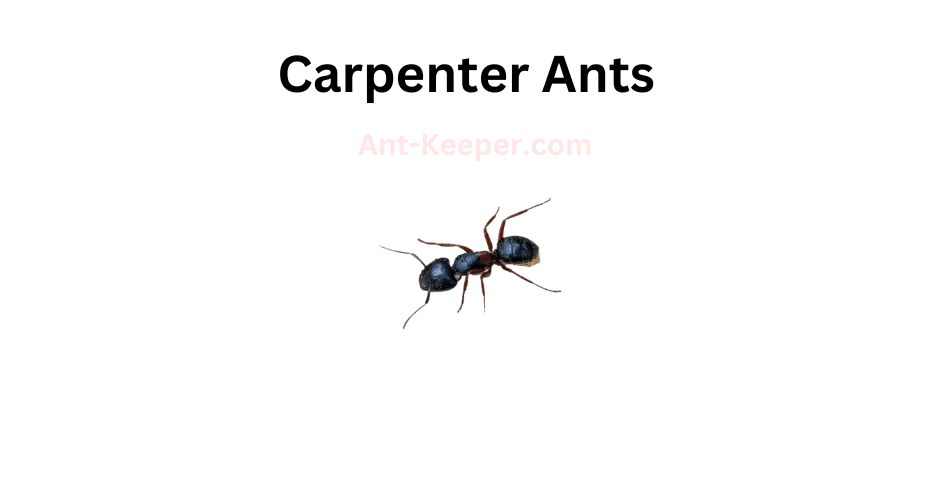
Carpenter ants are a species of ant that belong to the genus Camponotus.
They are known for their ability to excavate wood and create nests within it, which is why they are commonly referred to as "carpenter" ants.
These ants are typically black or red in color and can range in size from 6 to 12 millimeters in length.
Carpenter ants are social insects that live in colonies, which can range in size from a few hundred to several thousand individuals.
The colony is typically led by a queen ant, who is responsible for laying eggs and producing new members of the colony.
The workers, which make up the majority of the colony, are responsible for foraging for food, caring for the young, and maintaining the nest.
One of the most interesting aspects of carpenter ants is their ability to excavate wood.
Unlike termites, which eat wood, carpenter ants simply remove it to create their nests.
They do this by using their powerful mandibles to chew through the wood, creating tunnels and galleries that can extend several feet in length.
These tunnels are then used to house the colony and provide protection from predators and the elements.
Carpenter ants are also known for their role in the ecosystem.
They are important decomposers, breaking down dead wood and other organic matter and returning nutrients to the soil.
They also serve as a food source for other animals, including birds, reptiles, and mammals.
Despite their important ecological role, carpenter ants can also be a nuisance to humans.
They can cause damage to wooden structures, including homes and buildings, and can be difficult to control once they have established a nest.
However, with proper pest management techniques, it is possible to control carpenter ant populations and prevent damage to structures.
47) Black Carpenter Ants, Camponotus Pennsylvanicus
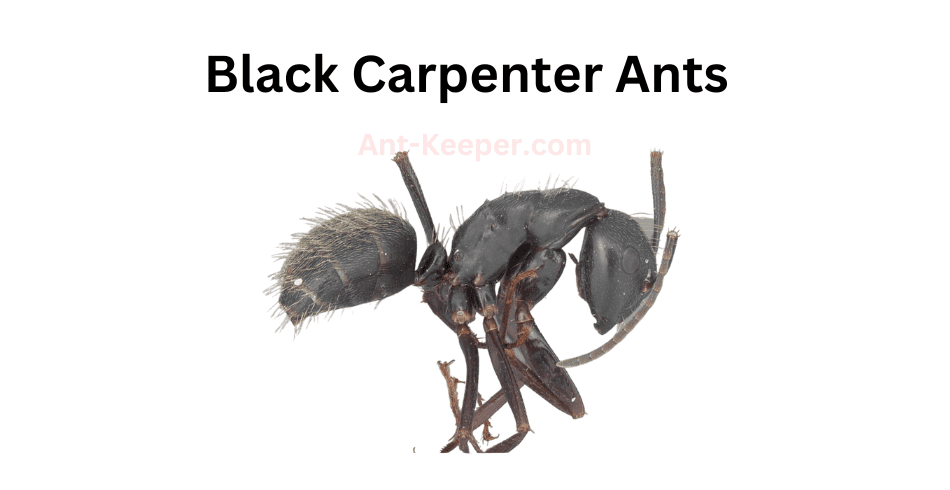
The Black Carpenter Ant (Camponotus pennsylvanicus) is a species of ant belonging to the family Formicidae.
These ants are commonly found in forests, woodlands, and urban areas across their range.
They are known for their large size, with workers measuring up to 1.5 cm in length.
Black Carpenter Ants are typically black in color, with some individuals having reddish-brown or yellowish hairs on their bodies.
They have a smooth and shiny exoskeleton, which helps to protect them from predators and environmental stressors.
These ants are known for their ability to excavate wood, which they use to create their nests.
They are often found in dead or decaying trees, but can also be found in wooden structures such as houses and buildings.
Black Carpenter Ants do not eat wood, but instead feed on a variety of insects, nectar, and honeydew.
The colony of Black Carpenter Ants is typically composed of a queen, workers, and soldiers.
The queen is responsible for laying eggs, while the workers are responsible for foraging, caring for the young, and maintaining the nest.
The soldiers are responsible for defending the colony against predators.
Black Carpenter Ants play an important role in their ecosystem, as they help to break down dead wood and recycle nutrients back into the soil.
However, they can also be considered a pest when they infest homes and buildings.
It is important to take preventative measures to avoid infestations, such as sealing cracks and crevices in the home and removing any decaying wood from the property.
48) Carpenter And Sugar Ants, Camponotus Subbarbatus

Carpenter ants and sugar ants are two common species of ants found in many regions of the world.
Carpenter ants are known for their ability to excavate wood and create nests within it.
They are typically larger in size than sugar ants and have a black or dark brown coloration.
Carpenter ants are also known for their strong mandibles, which they use to chew through wood and other materials.
Sugar ants, on the other hand, are smaller in size and have a yellow or brown coloration.
They are named for their preference for sugary foods and are often found in kitchens and other areas where food is stored.
Sugar ants are also known for their ability to form large colonies, with thousands of individual ants working together to gather food and care for their young.
Both carpenter ants and sugar ants play important roles in their ecosystems.
Carpenter ants help to break down dead wood and other plant material, which helps to recycle nutrients back into the soil.
Sugar ants help to disperse seeds and pollinate plants, which helps to maintain healthy ecosystems.
However, both species can also be pests when they invade human homes and buildings.
Carpenter ants can cause damage to wooden structures, while sugar ants can contaminate food and be a nuisance to homeowners.
It is important to take steps to prevent ant infestations and to control them if they do occur, in order to protect both human health and the health of the environment.
49) Acrobat Ants, Crematogaster Cerasi

Acrobat ants, also known as Crematogaster spp., are a genus of ants that are found in various parts of the world.
These ants are known for their unique ability to contort their bodies and move in acrobatic ways, hence their name.
Acrobat ants are relatively small, with workers measuring between 2-5mm in length.
They are typically brown or black in color, with a slender body and long legs.
These ants are known for their aggressive behavior and will readily defend their nests against intruders.
One of the most interesting features of acrobat ants is their ability to use their mandibles to grip onto surfaces and contort their bodies in unusual ways.
This allows them to move along narrow branches, twigs, and other surfaces that would be difficult for other ants to navigate.
They are also able to use this ability to escape from predators, such as birds and other insects.
Acrobat ants are omnivorous, meaning that they will eat both plant and animal matter.
They are known to feed on insects, nectar, and honeydew, as well as fruits and seeds.
These ants are also known to tend to aphids, protecting them from predators in exchange for the sweet honeydew that the aphids produce.
In terms of their social structure, acrobat ants are typically organized into colonies that are led by a queen.
The queen is responsible for laying eggs, while the workers are responsible for foraging, caring for the young, and defending the nest.
Overall, acrobat ants are fascinating creatures that have adapted unique abilities to survive in their environments.
Their acrobatic abilities and aggressive behavior make them a formidable force in the insect world.
50) Acrobat Ants, Crematogaster Lineolata

Acrobat ants, also known as Crematogaster spp., are a genus of ants that are found in various parts of the world.
These ants are known for their unique ability to contort their bodies and move in acrobatic ways, hence their name.
Acrobat ants are relatively small, with workers measuring between 2-5mm in length.
They are typically brown or black in color, with a slender body and long legs.
These ants are known for their aggressive behavior and will readily defend their nests against intruders.
One of the most interesting features of acrobat ants is their ability to use their mandibles to grip onto surfaces and contort their bodies in unusual ways.
This allows them to move along narrow branches, twigs, and other surfaces that would be difficult for other ants to navigate.
They are also able to use this ability to escape from predators, such as birds and other insects.
Acrobat ants are omnivorous, meaning that they will eat both plant and animal matter.
They are known to feed on insects, nectar, and honeydew, as well as fruits and seeds.
These ants are also known to tend to aphids, protecting them from predators in exchange for the sweet honeydew that the aphids produce.
In terms of their social structure, acrobat ants are typically organized into colonies that are led by a queen.
The queen is responsible for laying eggs, while the workers are responsible for foraging, caring for the young, and defending the nest.
Overall, acrobat ants are fascinating creatures that have adapted unique abilities to survive in their environments.
Their acrobatic abilities and aggressive behavior make them a formidable force in the insect world.
51) Wood Ants, Formica Exsectoides

Wood ants, also known as carpenter ants, are a species of ant that belong to the genus Camponotus.
They are widely distributed throughout the world and are commonly found in forests and woodlands.
These ants are known for their ability to excavate wood and create nests inside trees, logs, and other wooden structures.
Wood ants are typically large in size, with workers ranging from 6 to 13 millimeters in length.
They are usually black or brown in color and have a smooth, shiny exoskeleton.
These ants have strong mandibles that they use to chew through wood and defend their nests.
Wood ants are social insects that live in colonies consisting of a queen, workers, and soldiers.
The queen is responsible for laying eggs, while the workers and soldiers are responsible for maintaining the nest and protecting it from predators.
These ants communicate with each other using chemical signals called pheromones.
Wood ants are omnivores and feed on a variety of food sources, including insects, honeydew, and plant sap.
They are also known to scavenge for food and will sometimes raid the nests of other ant species.
Despite their ability to excavate wood, wood ants are not considered pests.
In fact, they play an important role in forest ecosystems by helping to decompose dead wood and recycle nutrients.
They also serve as a food source for many other animals, including birds, mammals, and other insects.
Overall, wood ants are fascinating creatures that have adapted to live in a unique habitat.
Their ability to excavate wood and create nests inside trees is a testament to their ingenuity and resourcefulness.
52) Silky Ants, Formica Fusca
Silky ants, also known as velvet ants, are a type of solitary wasp that belong to the family Mutillidae.
They are found in various habitats such as forests, deserts, and grasslands.
These ants are known for their striking appearance, with their bright colors and dense, velvety hair covering their bodies.
Silky ants are typically between 0.5 to 1.5 inches in length and have a distinct, elongated body shape.
They have a tough exoskeleton that protects them from predators and environmental stressors.
Their bright colors, which can range from red to orange to black, serve as a warning to potential predators that they are venomous and should be avoided.
Despite their name, silky ants do not actually belong to the ant family.
They are wingless females that resemble ants in their appearance and behavior.
The males, on the other hand, have wings and are often mistaken for bees.
Silky ants are known for their painful sting, which is used to defend themselves from predators.
Their venom is potent and can cause intense pain, swelling, and even anaphylactic shock in some individuals.
However, they are not aggressive and will only sting if provoked or threatened.
Silky ants are important pollinators and play a crucial role in maintaining the ecological balance of their habitats.
They feed on nectar and pollen from flowers and help to transfer pollen from one plant to another, aiding in the reproduction of various plant species.
In conclusion, silky ants are fascinating creatures that are both beautiful and dangerous.
Their unique appearance and behavior make them a valuable addition to the natural world.
53) Wood Ants, Formica Indianensis

Wood ants, also known as carpenter ants, are a species of ant that belong to the genus Camponotus.
They are widely distributed throughout the world and are commonly found in forests and woodlands.
These ants are known for their ability to excavate wood and create nests inside trees, logs, and other wooden structures.
Wood ants are typically large in size, with workers ranging from 6 to 13 millimeters in length.
They are usually black or brown in color and have a smooth, shiny exoskeleton.
These ants have strong mandibles that they use to chew through wood and defend their nests.
Wood ants are social insects that live in colonies consisting of a queen, workers, and soldiers.
The queen is responsible for laying eggs, while the workers and soldiers are responsible for maintaining the nest and protecting it from predators.
These ants communicate with each other using chemical signals called pheromones.
Wood ants are omnivores and feed on a variety of food sources, including insects, honeydew, and plant sap.
They are also known to scavenge for food and will sometimes raid the nests of other ant species.
Despite their ability to excavate wood, wood ants are not considered pests.
In fact, they play an important role in forest ecosystems by helping to decompose dead wood and recycle nutrients.
They also serve as a food source for many other animals, including birds, mammals, and other insects.
Overall, wood ants are fascinating creatures that have adapted to live in a unique habitat.
Their ability to excavate wood and create nests inside trees is a testament to their ingenuity and resourcefulness.
54) Wood Ants, Formica Neogagates

Wood ants, also known as carpenter ants, are a species of ant that belong to the genus Camponotus.
They are widely distributed throughout the world and are commonly found in forests and woodlands.
These ants are known for their ability to excavate wood and create nests inside trees, logs, and other wooden structures.
Wood ants are typically large in size, with workers ranging from 6 to 13 millimeters in length.
They are usually black or brown in color and have a smooth, shiny exoskeleton.
These ants have strong mandibles that they use to chew through wood and defend their nests.
Wood ants are social insects that live in colonies consisting of a queen, workers, and soldiers.
The queen is responsible for laying eggs, while the workers and soldiers are responsible for maintaining the nest and protecting it from predators.
These ants communicate with each other using chemical signals called pheromones.
Wood ants are omnivores and feed on a variety of food sources, including insects, honeydew, and plant sap.
They are also known to scavenge for food and will sometimes raid the nests of other ant species.
Despite their ability to excavate wood, wood ants are not considered pests.
In fact, they play an important role in forest ecosystems by helping to decompose dead wood and recycle nutrients.
They also serve as a food source for many other animals, including birds, mammals, and other insects.
Overall, wood ants are fascinating creatures that have adapted to live in a unique habitat.
Their ability to excavate wood and create nests inside trees is a testament to their ingenuity and resourcefulness.
55) Western Thatching Ants, Formica Obscuripes
The Western Thatching Ant, also known as Formica obscuripes, is a species of ant that belongs to the Formicidae family.
These ants are commonly found in grasslands and forests throughout the western region of North America.
They are known for their unique ability to construct thatched nests made of grass and other plant materials.
The Western Thatching Ant is a medium-sized ant, with workers ranging in size from 4 to 8 millimeters in length.
They are typically dark brown or black in color, with a shiny exoskeleton.
These ants are highly social, living in large colonies that can contain up to several thousand individuals.
One of the most distinctive features of the Western Thatching Ant is their nest-building behavior.
These ants construct elaborate thatched nests made of grass and other plant materials.
The thatch serves as insulation, helping to regulate the temperature and humidity inside the nest.
The ants also use the thatch to protect the nest from predators and other environmental factors.
The Western Thatching Ant is an omnivorous species, feeding on a variety of foods including insects, nectar, and honeydew.
They are also known to tend to aphids, which produce honeydew that the ants feed on.
These ants are important members of their ecosystem, playing a role in seed dispersal and soil aeration.
Overall, the Western Thatching Ant is a fascinating species of ant that is well-adapted to its environment.
Their unique nest-building behavior and social structure make them an interesting subject for study and observation.
56) Northern Red Wood Ants, Formica Obscuriventris
The Northern Red Wood Ant, also known as Formica rufa, is a species of ant that belongs to the family Formicidae.
These ants are commonly found in forests and woodlands, where they build large nests made of twigs, leaves, and other organic materials.
The Northern Red Wood Ant is a relatively large ant, with workers measuring up to 10mm in length.
They are reddish-brown in color, with a darker head and thorax.
These ants are known for their aggressive behavior and will defend their nests fiercely against intruders.
These ants are omnivorous, feeding on a variety of insects, as well as honeydew produced by aphids and other insects.
They are also known to scavenge for food, and will even attack and kill other insects to feed their colony.
The Northern Red Wood Ant is an important species in forest ecosystems, as they help to aerate the soil and control populations of other insects.
They are also an important food source for many birds and other animals.
Overall, the Northern Red Wood Ant is a fascinating species of ant that plays an important role in forest ecosystems.
Their large nests and aggressive behavior make them a unique and interesting species to observe in the wild.
57) Pale Field Ants, Formica Pallidefulva
Pale Field Ants, also known as Lasius pallitarsis, are a species of ant that belong to the family Formicidae.
These ants are commonly found in grassy fields and meadows, where they build their nests in the soil.
They are small in size, measuring only about 3-4 mm in length, and have a pale yellowish-brown coloration.
Pale Field Ants are known for their social behavior, as they live in large colonies that can contain thousands of individuals.
The colony is typically headed by a queen ant, who is responsible for laying eggs and maintaining the population.
The workers, which are sterile females, are responsible for foraging for food, caring for the young, and defending the colony.
These ants are omnivorous, meaning that they feed on both plant and animal matter.
They primarily feed on honeydew, a sweet substance produced by aphids and other insects, as well as on small insects and other arthropods.
They are also known to scavenge for food, and will consume dead insects and other organic matter.
Pale Field Ants play an important role in their ecosystem, as they help to aerate the soil and control the populations of other insects.
They are also an important food source for many other animals, including birds and small mammals.
Overall, Pale Field Ants are a fascinating species of ant that are well adapted to life in grassy fields and meadows.
Their social behavior, diet, and ecological role make them an important part of many ecosystems around the world.
58) Wood Ants, Formica Pergandei

Wood ants, also known as carpenter ants, are a species of ant that belong to the genus Camponotus.
They are widely distributed throughout the world and are commonly found in forests and woodlands.
These ants are known for their ability to excavate wood and create nests inside trees, logs, and other wooden structures.
Wood ants are typically large in size, with workers ranging from 6 to 13 millimeters in length.
They are usually black or brown in color and have a smooth, shiny exoskeleton.
These ants have strong mandibles that they use to chew through wood and defend their nests.
Wood ants are social insects that live in colonies consisting of a queen, workers, and soldiers.
The queen is responsible for laying eggs, while the workers and soldiers are responsible for maintaining the nest and protecting it from predators.
These ants communicate with each other using chemical signals called pheromones.
Wood ants are omnivores and feed on a variety of food sources, including insects, honeydew, and plant sap.
They are also known to scavenge for food and will sometimes raid the nests of other ant species.
Despite their ability to excavate wood, wood ants are not considered pests.
In fact, they play an important role in forest ecosystems by helping to decompose dead wood and recycle nutrients.
They also serve as a food source for many other animals, including birds, mammals, and other insects.
Overall, wood ants are fascinating creatures that have adapted to live in a unique habitat.
Their ability to excavate wood and create nests inside trees is a testament to their ingenuity and resourcefulness.
59) Wood Ants, Formica Postoculata

Wood ants, also known as carpenter ants, are a species of ant that belong to the genus Camponotus.
They are widely distributed throughout the world and are commonly found in forests and woodlands.
These ants are known for their ability to excavate wood and create nests inside trees, logs, and other wooden structures.
Wood ants are typically large in size, with workers ranging from 6 to 13 millimeters in length.
They are usually black or brown in color and have a smooth, shiny exoskeleton.
These ants have strong mandibles that they use to chew through wood and defend their nests.
Wood ants are social insects that live in colonies consisting of a queen, workers, and soldiers.
The queen is responsible for laying eggs, while the workers and soldiers are responsible for maintaining the nest and protecting it from predators.
These ants communicate with each other using chemical signals called pheromones.
Wood ants are omnivores and feed on a variety of food sources, including insects, honeydew, and plant sap.
They are also known to scavenge for food and will sometimes raid the nests of other ant species.
Despite their ability to excavate wood, wood ants are not considered pests.
In fact, they play an important role in forest ecosystems by helping to decompose dead wood and recycle nutrients.
They also serve as a food source for many other animals, including birds, mammals, and other insects.
Overall, wood ants are fascinating creatures that have adapted to live in a unique habitat.
Their ability to excavate wood and create nests inside trees is a testament to their ingenuity and resourcefulness.
60) Ruddy Slave-Making Mound Ants, Formica Rubicunda
The Ruddy Slave-Making Mound Ants, also known as Polyergus breviceps, are a species of ants that belong to the Formicidae family.
These ants are known for their unique behavior of raiding and enslaving other ant colonies, which is why they are commonly referred to as slave-making ants.
The Ruddy Slave-Making Mound Ants are typically reddish-brown in color and have a distinctively large head compared to their body size.
They are also known for their sharp mandibles, which they use to capture and subdue their prey.
These ants are social insects and live in large colonies that can consist of up to several thousand individuals.
The colony is typically divided into different castes, including workers, soldiers, and reproductive ants.
One of the most interesting aspects of the Ruddy Slave-Making Mound Ants is their behavior of raiding and enslaving other ant colonies.
The ants will send out raiding parties to neighboring colonies, where they will capture and bring back pupae and larvae.
These young ants are then raised by the Ruddy Slave-Making Mound Ants and forced to work as slaves within their own colony.
Despite their aggressive behavior, the Ruddy Slave-Making Mound Ants play an important role in their ecosystem.
They help to control the population of other ant species and can even help to spread beneficial bacteria throughout the soil.
Overall, the Ruddy Slave-Making Mound Ants are a fascinating species of ants that exhibit unique and complex behaviors.
Their ability to enslave other ant colonies is a testament to their intelligence and adaptability in the natural world.
61) Obligate Slave-Making Mound Ants, Formica Subintegra
Obligate slave-making mound ants are a species of ants that are known for their unique behavior of enslaving other ant species.
These ants are also known as dulotic ants, and they are found in various parts of the world.
The obligate slave-making mound ants have a complex social structure, which is similar to other ant species.
However, they have a unique behavior of raiding the nests of other ant species and capturing their pupae.
The pupae are then taken back to the slave-making ant colony, where they are raised as workers.
The slave-making ants rely on the enslaved ants to perform various tasks, such as foraging, nest maintenance, and caring for the brood.
The enslaved ants are also responsible for defending the colony against predators and other threats.
The obligate slave-making mound ants have a distinct physical appearance, with a dark brown or black coloration.
They are also larger than the enslaved ants, with a length of up to 10 mm.
The queen ants are even larger, with a length of up to 15 mm.
The obligate slave-making mound ants are known to have a significant impact on the ecology of the areas where they are found.
They can reduce the population of other ant species, which can have a cascading effect on the entire ecosystem.
In conclusion, the obligate slave-making mound ants are a fascinating species of ants that have evolved a unique behavior of enslaving other ant species.
Their complex social structure and reliance on enslaved ants make them an important species to study in the field of entomology.
62) Wood Ants, Formica Ulkei

Wood ants, also known as carpenter ants, are a species of ant that belong to the genus Camponotus.
They are widely distributed throughout the world and are commonly found in forests and woodlands.
These ants are known for their ability to excavate wood and create nests inside trees, logs, and other wooden structures.
Wood ants are typically large in size, with workers ranging from 6 to 13 millimeters in length.
They are usually black or brown in color and have a smooth, shiny exoskeleton.
These ants have strong mandibles that they use to chew through wood and defend their nests.
Wood ants are social insects that live in colonies consisting of a queen, workers, and soldiers.
The queen is responsible for laying eggs, while the workers and soldiers are responsible for maintaining the nest and protecting it from predators.
These ants communicate with each other using chemical signals called pheromones.
Wood ants are omnivores and feed on a variety of food sources, including insects, honeydew, and plant sap.
They are also known to scavenge for food and will sometimes raid the nests of other ant species.
Despite their ability to excavate wood, wood ants are not considered pests.
In fact, they play an important role in forest ecosystems by helping to decompose dead wood and recycle nutrients.
They also serve as a food source for many other animals, including birds, mammals, and other insects.
Overall, wood ants are fascinating creatures that have adapted to live in a unique habitat.
Their ability to excavate wood and create nests inside trees is a testament to their ingenuity and resourcefulness.
63) Cornfield Ants, Lasius Alienus
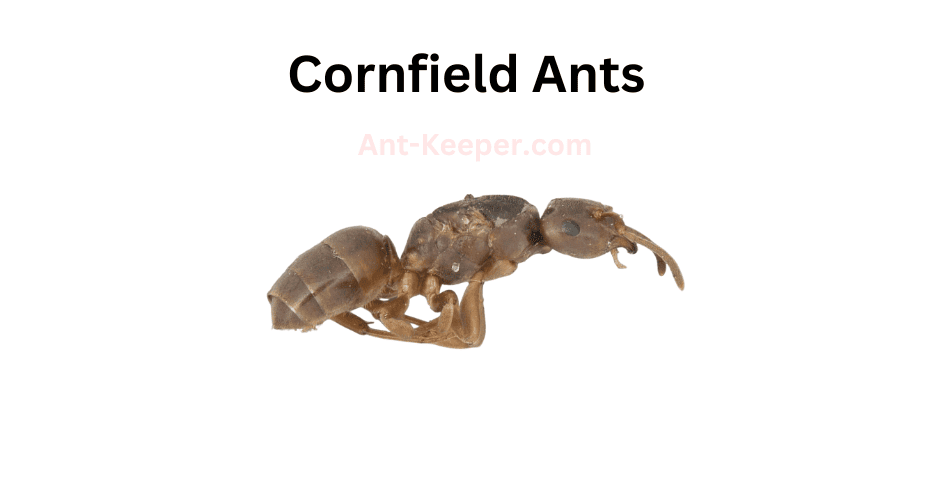
Cornfield ants, also known as Lasius neoniger, are a species of ant that belong to the Formicidae family.
These ants are commonly found in agricultural fields and grasslands, where they build their nests in the soil.
They are known for their ability to form large colonies, with thousands of individuals living together in a single nest.
Cornfield ants are small in size, measuring between 2.5 and 4 mm in length.
They are typically black or dark brown in color, with a shiny and smooth exoskeleton.
These ants are omnivorous, feeding on a variety of food sources including insects, seeds, and honeydew produced by aphids.
One of the most interesting aspects of cornfield ants is their ability to form symbiotic relationships with other insects.
They are known to protect and care for aphids, which in turn produce honeydew that the ants feed on.
This relationship benefits both the ants and the aphids, as the ants receive a reliable food source while the aphids are protected from predators.
Cornfield ants are also important for their role in soil health.
Their nests help to aerate the soil and improve its structure, which can benefit plant growth.
Additionally, their foraging activities help to distribute nutrients throughout the soil.
Overall, cornfield ants are an important species in agricultural ecosystems.
Their ability to form large colonies and symbiotic relationships with other insects make them a fascinating subject for study.
64) Moisture Ants, Lasius Claviger

Moisture ants are a type of ant that is commonly found in damp environments.
They are known for their ability to thrive in areas with high levels of moisture, such as in rotting wood or in soil that is constantly moist.
These ants are typically small in size, measuring only a few millimeters in length, and are usually yellow or brown in color.
Moisture ants are social insects that live in colonies, with each colony consisting of a queen, workers, and soldiers.
The queen is responsible for laying eggs, while the workers and soldiers are responsible for maintaining the colony and protecting it from predators.
One of the unique characteristics of moisture ants is their ability to create satellite colonies.
These colonies are established in nearby locations and are connected to the main colony by a network of tunnels.
This allows the ants to expand their territory and increase their chances of survival.
Moisture ants are also known for their ability to control the moisture levels in their environment.
They do this by building intricate nests that are designed to regulate the humidity levels inside.
This is important for the survival of the colony, as too much moisture can lead to the growth of harmful fungi and bacteria.
Overall, moisture ants are fascinating creatures that have adapted to thrive in environments that would be inhospitable to many other species.
Their ability to control moisture levels and create satellite colonies makes them a formidable force in their ecosystem.
65) Yellow Meadow Ants, Lasius Flavus
Yellow Meadow Ants, also known as Lasius flavus, are a species of ant that belong to the Formicidae family.
They are commonly found in meadows, grasslands, and other open areas with well-drained soil.
These ants are small in size, measuring between 3-5mm in length, and have a yellowish-brown coloration.
Yellow Meadow Ants are social insects that live in colonies consisting of a queen, male ants, and worker ants.
The queen is responsible for laying eggs, while the worker ants are responsible for foraging for food, caring for the young, and defending the colony.
The male ants are responsible for mating with the queen.
These ants are omnivorous, meaning they feed on both plant and animal matter.
They primarily feed on honeydew, a sweet substance produced by aphids and other insects, as well as other insects and small invertebrates.
Yellow Meadow Ants are also known to cultivate and protect aphids, which they use as a source of food.
Yellow Meadow Ants are important members of their ecosystem, as they help to aerate the soil and control the populations of other insects.
They are also preyed upon by a variety of animals, including birds, spiders, and other insects.
Overall, Yellow Meadow Ants are fascinating creatures that play an important role in their environment.
Their social behavior and unique adaptations make them a valuable subject of study for scientists and nature enthusiasts alike.
66) Larger Citronella Ants, Lasius Interjectus
The Larger Citronella Ants, also known as Acanthomyops interjectus, are a species of ant that belong to the Formicidae family.
These ants are typically larger in size compared to other ant species, with workers measuring up to 6mm in length and queens measuring up to 9mm in length.
The Larger Citronella Ants are known for their distinct citronella-like odor, which is emitted from their bodies as a form of defense against predators.
This odor is also used to communicate with other members of the colony, particularly during foraging activities.
These ants are typically found in wooded areas and forests, where they build their nests in soil or under rocks.
The nests of Larger Citronella Ants can be quite large, with multiple chambers and tunnels that can extend several feet underground.
The diet of Larger Citronella Ants consists mainly of honeydew, which is a sugary substance produced by aphids and other insects.
They also feed on other insects and small invertebrates, which they capture using their strong mandibles.
Larger Citronella Ants are known for their aggressive behavior, particularly when their nests are disturbed.
They will swarm and attack intruders, using their powerful mandibles to defend their colony.
Overall, the Larger Citronella Ants are an interesting and unique species of ant, known for their large size, distinct odor, and aggressive behavior.
67) Wide-Legged Citronella Ants, Lasius Latipes
The Wide-Legged Citronella Ants, also known as Acanthomyrmex ferox, are a species of ants that belong to the Formicidae family.
These ants are known for their distinct appearance, with their long and slender legs that are wider than their body.
They are typically reddish-brown in color and have a strong citronella odor.
The Wide-Legged Citronella Ants are found in tropical and subtropical regions, where they inhabit forests and grasslands.
They are known to be aggressive and territorial, often engaging in battles with other ant species for resources and territory.
These ants are omnivorous, feeding on a variety of food sources including insects, nectar, and plant sap.
They are also known to cultivate fungi in their nests, which they use as a food source.
The Wide-Legged Citronella Ants are social insects, living in colonies that can range from a few hundred to several thousand individuals.
They have a complex social structure, with different castes of ants performing specific roles within the colony.
The queen ant is responsible for laying eggs, while the worker ants are responsible for foraging, caring for the young, and defending the colony.
Overall, the Wide-Legged Citronella Ants are an important part of the ecosystem, playing a role in seed dispersal, soil aeration, and nutrient cycling.
However, their aggressive behavior and territorial nature can sometimes make them a nuisance to humans.
68) Labour Day Ants, Lasius Neoniger
The Labour Day Ants, also known as the May Day Ants, are a species of ants that are commonly found in temperate regions around the world.
These ants are known for their hardworking nature and their ability to work together as a team to achieve their goals.
The Labour Day Ants are social insects that live in large colonies, which can consist of thousands of individuals.
The colony is usually led by a queen ant, who is responsible for laying eggs and producing new members of the colony.
The other ants in the colony are divided into different castes, including workers, soldiers, and reproductive ants.
The workers are the most numerous members of the colony and are responsible for gathering food, caring for the young, and maintaining the nest.
These ants are known for their tireless work ethic and their ability to work together to accomplish tasks.
They are also known for their ability to carry objects that are many times their own body weight.
The soldiers are responsible for defending the colony from predators and other threats.
These ants have larger heads and mandibles than the workers and are capable of delivering a painful bite to any intruders.
The reproductive ants are responsible for mating and producing new members of the colony.
These ants have wings and are capable of flying to new locations to start new colonies.
Overall, the Labour Day Ants are a fascinating species of ants that are known for their hardworking nature and their ability to work together as a team.
They are an important part of many ecosystems and play a vital role in maintaining the balance of nature.
69) Black Garden Ants, Lasius Niger
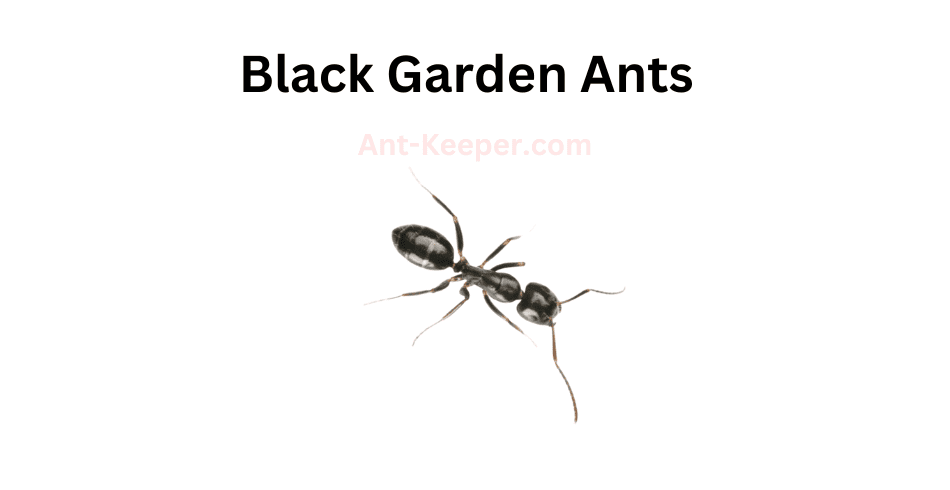
The Black Garden Ant, also known as Lasius niger, is a common species of ant found in many parts of the world.
These ants are typically black or dark brown in color and range in size from 2.5 to 4 mm in length.
Black Garden Ants are social insects that live in large colonies, which can contain thousands of individuals.
The colony is typically led by a queen ant, who is responsible for laying eggs and producing new workers.
The workers are responsible for foraging for food, caring for the young, and defending the colony from predators.
These ants are omnivorous and will eat a variety of foods, including insects, nectar, and honeydew.
They are also known to farm aphids, which they protect and feed in exchange for the sweet honeydew they produce.
Black Garden Ants are important members of their ecosystem, as they help to aerate soil and control populations of other insects.
However, they can also be considered pests when they invade homes and gardens in search of food and shelter.
Overall, the Black Garden Ant is a fascinating and important species of ant that plays a vital role in many ecosystems around the world.
70) Moisture Ants, Lasius Speculiventris

Moisture ants are a type of ant that is commonly found in damp environments.
They are known for their ability to thrive in areas with high levels of moisture, such as in rotting wood or in soil that is constantly moist.
These ants are typically small in size, measuring only a few millimeters in length, and are usually yellow or brown in color.
Moisture ants are social insects that live in colonies, with each colony consisting of a queen, workers, and soldiers.
The queen is responsible for laying eggs, while the workers and soldiers are responsible for maintaining the colony and protecting it from predators.
One of the unique characteristics of moisture ants is their ability to create satellite colonies.
These colonies are established in nearby locations and are connected to the main colony by a network of tunnels.
This allows the ants to expand their territory and increase their chances of survival.
Moisture ants are also known for their ability to control the moisture levels in their environment.
They do this by building intricate nests that are designed to regulate the humidity levels inside.
This is important for the survival of the colony, as too much moisture can lead to the growth of harmful fungi and bacteria.
Overall, moisture ants are fascinating creatures that have adapted to thrive in environments that would be inhospitable to many other species.
Their ability to control moisture levels and create satellite colonies makes them a formidable force in their ecosystem.
71) Yellow Shadow Ants, Lasius Umbratus
Yellow Shadow Ants, also known as Oecophylla smaragdina, are a species of arboreal ant found in tropical regions around the world.
These ants are known for their distinctive yellow coloration and their ability to form large colonies in trees.
Yellow Shadow Ants are highly social insects, with colonies consisting of thousands of individuals.
They are known for their aggressive behavior and their ability to defend their territory from other ant species and predators.
These ants are also known for their unique nesting behavior, which involves weaving together leaves and other plant materials to create a nest in the canopy of trees.
One of the most interesting aspects of Yellow Shadow Ant behavior is their use of larvae as a form of defense.
When threatened, worker ants will carry larvae to the edge of the nest and use them to attack intruders.
The larvae have a sticky secretion that can immobilize predators, allowing the worker ants to attack and drive them away.
Yellow Shadow Ants are also important for their role in ecosystem functioning.
They are known to be effective predators of other insects, and their presence can help to control pest populations in agricultural areas.
Additionally, their nesting behavior can help to improve soil quality and nutrient cycling in forest ecosystems.
Overall, Yellow Shadow Ants are a fascinating and important species of ant that play an important role in tropical ecosystems around the world.
72) Little Black Ants, Monomorium Minimum
The Little Black Ant, also known as Monomorium minimum, is a species of ant that belongs to the family Formicidae.
These ants are small in size, measuring only 1.5 to 2.5 mm in length, and are typically black or dark brown in color.
Little Black Ants are commonly found in urban and suburban areas, where they nest in soil, under rocks, and in cracks and crevices.
They are also known to nest in buildings, particularly in wall voids and under floors.
These ants are omnivorous, feeding on a variety of foods including insects, honeydew, and plant nectar.
They are also known to scavenge for food in homes and other buildings, often attracted to sweet and greasy foods.
Little Black Ants are social insects, living in colonies that can range in size from a few dozen to several thousand individuals.
The colony is typically headed by a queen, who is responsible for laying eggs and producing new workers.
These ants are known for their ability to quickly infest an area, making them a nuisance pest in homes and other buildings.
They are also known to bite when disturbed, although their bites are not typically harmful to humans.
Overall, the Little Black Ant is a common and adaptable species that can be found in a variety of environments.
While they can be a nuisance pest, they also play an important role in the ecosystem as predators and scavengers.
73) American Mite-Eating Ants, Myrmecina Americana
The American Mite-Eating Ants, also known as Acropyga, are a genus of ants that belong to the Formicidae family.
These ants are known for their unique feeding habits, as they primarily feed on mites that live on the leaves of plants.
The American Mite-Eating Ants are small in size, with workers measuring between 1.5 to 2.5 millimeters in length.
They have a dark brown or black coloration and a slender body shape.
These ants are known for their ability to form symbiotic relationships with other organisms, particularly with a species of mite known as the Acaromyces.
The Acaromyces mites live on the leaves of plants and feed on the sap that the plant produces.
The American Mite-Eating Ants have developed a unique relationship with these mites, as they feed on the mites and in return, the mites provide the ants with a source of nutrition.
The mites produce a nutrient-rich liquid that the ants consume, which provides them with essential amino acids and other nutrients that they cannot obtain from their diet of mites alone.
The American Mite-Eating Ants are found in a variety of habitats, including forests, grasslands, and deserts.
They are known for their ability to form large colonies, with some colonies containing up to several thousand individuals.
These ants are also known for their aggressive behavior towards other ant species, as they will defend their territory and resources from intruders.
In conclusion, the American Mite-Eating Ants are a unique species of ants that have developed a symbiotic relationship with a species of mite.
They are small in size, but are known for their aggressive behavior and ability to form large colonies.
These ants play an important role in the ecosystem by controlling the population of mites on plants and providing a source of nutrition for other organisms.
74) Furrowed Ants, Myrmica Pinetorum

Furrowed ants, also known as Pheidole ruginoda, are a species of ant that belong to the family Formicidae.
These ants are commonly found in various habitats such as forests, grasslands, and deserts.
They are known for their distinctive appearance, with a furrowed head and thorax, and a smooth and shiny abdomen.
Furrowed ants are social insects that live in colonies, which can range in size from a few hundred to several thousand individuals.
The colony is typically headed by a queen ant, whose primary role is to lay eggs.
The workers, which are sterile females, are responsible for foraging, nest maintenance, and caring for the young.
These ants are omnivorous, meaning they feed on both plant and animal matter.
Their diet consists of seeds, insects, and other small invertebrates.
They are also known to tend to aphids, which produce a sugary substance that the ants feed on.
Furrowed ants are known for their aggressive behavior, and will defend their colony fiercely against intruders.
They have been observed engaging in territorial battles with other ant species, and will even attack larger insects such as grasshoppers and beetles.
Overall, furrowed ants are an important part of many ecosystems, playing a crucial role in seed dispersal and soil aeration.
Their unique appearance and behavior make them a fascinating subject for study and observation.
75) Punctured Ants, Myrmica Punctiventris
The Punctured Ant, scientifically known as Tetramorium punctulatum, is a species of ant that belongs to the family Formicidae.
These ants are small in size, measuring between 2.5 to 3.5 mm in length, and are typically black or dark brown in color.
One of the distinguishing features of the Punctured Ant is the presence of punctures on their head and thorax.
These punctures are small indentations on the ant's exoskeleton and are believed to play a role in the ant's ability to communicate with other members of their colony.
Punctured Ants are known to be highly social insects, living in large colonies that can contain thousands of individuals.
They are typically found in a variety of habitats, including forests, grasslands, and urban areas.
These ants are omnivorous, feeding on a variety of food sources including insects, nectar, and honeydew.
They are also known to scavenge for food, often raiding the nests of other ant species to steal their food.
The Punctured Ant is considered to be a nuisance pest in some areas, as they can invade homes and buildings in search of food and nesting sites.
However, they are not known to cause any significant damage or harm to humans.
Overall, the Punctured Ant is an interesting and important species of ant, playing a vital role in their ecosystem and providing valuable insights into the behavior and social structure of ants.
76) Big Headed Ants, Pheidole Bicarinata

Big Headed Ants, also known as Pheidole megacephala, are a species of ant that belong to the family Formicidae.
These ants are known for their distinctive large heads, which are used for defense and communication within their colonies.
Big Headed Ants are typically found in tropical and subtropical regions, where they build their nests in soil, leaf litter, and other organic matter.
They are omnivorous, feeding on a variety of insects, seeds, and other small organisms.
One of the most interesting aspects of Big Headed Ants is their social behavior.
They live in large colonies, with a queen ant at the center of the hierarchy.
The queen is responsible for laying eggs, while the other ants in the colony perform various tasks such as foraging for food, caring for the young, and defending the colony from predators.
Big Headed Ants are also known for their ability to displace other ant species in their habitats.
They are aggressive and have been known to attack and kill other ants, as well as compete with them for resources.
Despite their aggressive behavior, Big Headed Ants are not considered a major pest species.
However, their ability to displace other ant species and their potential impact on native ecosystems make them an important species to study and monitor.
77) Hairy Big Headed Ants, Pheidole Pilifera
Hairy Big Headed Ants, also known as Pheidole megacephala, are a species of ant that belong to the family Formicidae.
These ants are known for their large heads, which are disproportionately larger than their bodies.
The workers of this species can range in size from 2 to 5 millimeters in length, with the queen being the largest at around 7 millimeters.
The Hairy Big Headed Ants are native to tropical and subtropical regions and are commonly found in urban areas.
They are known to be highly adaptable and can thrive in a variety of environments, including forests, grasslands, and even deserts.
These ants are also known for their aggressive behavior and are known to be highly territorial.
The diet of Hairy Big Headed Ants consists of a variety of foods, including insects, seeds, and nectar.
They are also known to be scavengers and will feed on dead animals and other organic matter.
These ants are known for their ability to forage over long distances, and they will often form large trails to food sources.
Hairy Big Headed Ants are social insects and live in colonies that can range in size from a few hundred to several thousand individuals.
The colonies are typically organized into a caste system, with the queen being the reproductive member and the workers being responsible for foraging, nest maintenance, and caring for the brood.
Overall, Hairy Big Headed Ants are an interesting and important species of ant.
While they can be a nuisance in urban areas, they play an important role in their ecosystems and are fascinating to observe in their natural habitats.
78) Amazon Ants, Polyergus Breviceps

The Amazon Ant, also known as the Polyergus breviceps, is a species of ant that belongs to the Formicidae family.
These ants are known for their unique behavior of raiding other ant colonies and stealing their brood to raise as their own.
The Amazon Ants are typically black or dark brown in color and have a slender body with long legs.
They are relatively small in size, with workers measuring around 4-5 mm in length.
The queen ants are slightly larger, measuring around 7-8 mm in length.
These ants are social insects and live in large colonies that can consist of thousands of individuals.
The colonies are usually divided into different castes, including workers, soldiers, and reproductive ants.
The workers are responsible for foraging, caring for the brood, and maintaining the nest, while the soldiers defend the colony from predators.
One of the most interesting aspects of the Amazon Ants is their unique behavior of raiding other ant colonies.
They do this by sending out a group of specialized workers, known as raiders, to infiltrate the target colony.
The raiders then steal the brood of the target colony and bring it back to their own nest.
Once the stolen brood hatches, the Amazon Ants use it to increase their own workforce.
The Amazon Ants are also known for their symbiotic relationship with a species of butterfly known as the Maculinea rebeli.
The butterfly larvae feed on the brood of the Amazon Ants, but in return, they secrete a substance that makes the ants more aggressive and better at raiding other colonies.
Overall, the Amazon Ants are fascinating creatures with unique behaviors and adaptations that allow them to thrive in their environment.
79) Amazon Ants, Polyergus Lucidus

The Amazon Ant, also known as the Polyergus breviceps, is a species of ant that belongs to the Formicidae family.
These ants are known for their unique behavior of raiding other ant colonies and stealing their brood to raise as their own.
The Amazon Ants are typically black or dark brown in color and have a slender body with long legs.
They are relatively small in size, with workers measuring around 4-5 mm in length.
The queen ants are slightly larger, measuring around 7-8 mm in length.
These ants are social insects and live in large colonies that can consist of thousands of individuals.
The colonies are usually divided into different castes, including workers, soldiers, and reproductive ants.
The workers are responsible for foraging, caring for the brood, and maintaining the nest, while the soldiers defend the colony from predators.
One of the most interesting aspects of the Amazon Ants is their unique behavior of raiding other ant colonies.
They do this by sending out a group of specialized workers, known as raiders, to infiltrate the target colony.
The raiders then steal the brood of the target colony and bring it back to their own nest.
Once the stolen brood hatches, the Amazon Ants use it to increase their own workforce.
The Amazon Ants are also known for their symbiotic relationship with a species of butterfly known as the Maculinea rebeli.
The butterfly larvae feed on the brood of the Amazon Ants, but in return, they secrete a substance that makes the ants more aggressive and better at raiding other colonies.
Overall, the Amazon Ants are fascinating creatures with unique behaviors and adaptations that allow them to thrive in their environment.
80) Western Amazon Ants, Polyergus Mexicanus
The Western Amazon Ants, also known as the Atta cephalotes, are a species of leaf-cutter ants found in the tropical rainforests of South America.
These ants are known for their impressive ability to cut and transport large pieces of leaves, which they use to cultivate a fungus that serves as their primary food source.
The Western Amazon Ants are social insects that live in large colonies, with each colony consisting of millions of individuals.
The colony is organized into different castes, with the queen being the largest and most important member.
The queen is responsible for laying eggs, which hatch into larvae that are cared for by the worker ants.
The worker ants are the ones responsible for cutting and transporting the leaves, as well as tending to the fungus gardens.
They are also responsible for defending the colony against predators and other threats.
The soldiers, which are larger and more heavily armored than the workers, are responsible for protecting the colony from larger predators.
The Western Amazon Ants are important members of the rainforest ecosystem, as they help to break down and recycle organic matter.
They also serve as a food source for many other animals, including birds, reptiles, and mammals.
Despite their importance, the Western Amazon Ants are facing threats from habitat destruction and climate change.
As their habitat is destroyed, their populations are declining, which could have serious consequences for the rainforest ecosystem as a whole.
Conservation efforts are underway to protect these important insects and their habitat.
81) Amazon Ants, Polyergus Montivagus

The Amazon Ant, also known as the Polyergus breviceps, is a species of ant that belongs to the Formicidae family.
These ants are known for their unique behavior of raiding other ant colonies and stealing their brood to raise as their own.
The Amazon Ants are typically black or dark brown in color and have a slender body with long legs.
They are relatively small in size, with workers measuring around 4-5 mm in length.
The queen ants are slightly larger, measuring around 7-8 mm in length.
These ants are social insects and live in large colonies that can consist of thousands of individuals.
The colonies are usually divided into different castes, including workers, soldiers, and reproductive ants.
The workers are responsible for foraging, caring for the brood, and maintaining the nest, while the soldiers defend the colony from predators.
One of the most interesting aspects of the Amazon Ants is their unique behavior of raiding other ant colonies.
They do this by sending out a group of specialized workers, known as raiders, to infiltrate the target colony.
The raiders then steal the brood of the target colony and bring it back to their own nest.
Once the stolen brood hatches, the Amazon Ants use it to increase their own workforce.
The Amazon Ants are also known for their symbiotic relationship with a species of butterfly known as the Maculinea rebeli.
The butterfly larvae feed on the brood of the Amazon Ants, but in return, they secrete a substance that makes the ants more aggressive and better at raiding other colonies.
Overall, the Amazon Ants are fascinating creatures with unique behaviors and adaptations that allow them to thrive in their environment.
82) Pennslyvanian Hunter Ants, Ponera Pennsylvanica
The Pennsylvanian Hunter Ants, also known as the P.
hunteri, are a species of ants that belong to the Formicidae family.
These ants are known for their aggressive hunting behavior and are considered one of the most efficient predators in their ecosystem.
The Pennsylvanian Hunter Ants are relatively small in size, with workers measuring around 4-5 mm in length.
They have a dark brown or black coloration and possess strong mandibles that they use to capture their prey.
These ants are also known for their keen sense of smell, which they use to locate their prey.
The Pennsylvanian Hunter Ants are primarily carnivorous and feed on a variety of insects, including other ants, termites, and caterpillars.
They are also known to scavenge on dead animals and consume nectar and honeydew from plants.
These ants are highly social and live in large colonies that can consist of thousands of individuals.
The colony is led by a queen ant, who is responsible for laying eggs and maintaining the colony's population.
The workers in the colony are responsible for foraging, caring for the young, and defending the colony from predators.
The Pennsylvanian Hunter Ants are an important part of their ecosystem, as they help to control the population of other insects.
They are also used in scientific research to study their behavior and social structure.
Overall, the Pennsylvanian Hunter Ants are fascinating creatures that play a vital role in their environment.
83) Small Honey Ants, Prenolepis Imparis
Small Honey Ants, also known as Prenolepis imparis, are a species of ant that belong to the family Formicidae.
They are typically small in size, measuring between 2.5 to 3.5 mm in length.
These ants are commonly found in forests, grasslands, and other natural habitats.
Small Honey Ants are known for their sweet tooth, as they primarily feed on honeydew produced by aphids and other insects.
They also consume nectar and other sugary substances.
In addition to their sweet diet, these ants also feed on small insects and other arthropods.
Small Honey Ants are social insects, living in colonies that can range in size from a few dozen to several thousand individuals.
The colony is typically led by a queen ant, who is responsible for laying eggs and maintaining the overall health of the colony.
The workers, which make up the majority of the colony, are responsible for foraging for food, caring for the young, and defending the colony from predators.
One unique characteristic of Small Honey Ants is their ability to store food in their bodies.
The workers have a specialized crop, called a "social stomach," which allows them to store and transport food back to the colony.
This food storage system is particularly important during times of scarcity, as it allows the colony to survive on stored food until more resources become available.
Overall, Small Honey Ants are an important part of many ecosystems, playing a key role in pollination and nutrient cycling.
While they may be a nuisance to humans when they invade homes or gardens, they are generally harmless and can be easily controlled with non-toxic methods.
84) Spider Egg Ants, Proceratium Silaceum
The Spider Egg Ant, also known as the Pheidole pallidula, is a species of ant that belongs to the family Formicidae.
These ants are commonly found in various habitats, including forests, grasslands, and urban areas.
They are known for their unique behavior of stealing spider eggs and raising them as their own.
The Spider Egg Ants are small in size, measuring around 2-3 mm in length.
They have a yellowish-brown color and a distinct head with large mandibles.
These ants are known for their aggressive behavior and are often seen attacking other ant colonies to steal their food and resources.
One of the most interesting behaviors of the Spider Egg Ants is their habit of stealing spider eggs.
They locate spider egg sacs and carry them back to their nest.
Once inside the nest, the ants take care of the eggs as if they were their own.
They protect the eggs from predators and provide them with food until they hatch.
The Spider Egg Ants are also known for their complex social structure.
They have a queen ant that is responsible for laying eggs and reproducing.
The worker ants are responsible for foraging, caring for the young, and defending the colony.
The soldier ants are larger and have stronger mandibles, which they use to protect the colony from predators.
In conclusion, the Spider Egg Ants are a fascinating species of ant that exhibit unique behaviors such as stealing spider eggs and raising them as their own.
They have a complex social structure and are known for their aggressive behavior.
These ants play an important role in their ecosystem and are a valuable subject of study for scientists.
85) Thief Ants, Solenopsis Molesta
Thief ants, also known as Solenopsis molesta, are a species of small, yellowish-brown ants that are commonly found in various habitats such as forests, grasslands, and urban areas.
These ants are known for their thieving behavior, as they often invade the nests of other ant species to steal their food and resources.
Thief ants are relatively small, measuring only about 1.5 to 2.5 mm in length.
They have a distinctive yellowish-brown coloration, with a darker head and thorax.
Their antennae are 12-segmented, and they have a pair of large compound eyes.
These ants have a stinger, but it is not very potent and is rarely used for defense.
Thief ants are social insects that live in colonies consisting of thousands of individuals.
They have a hierarchical social structure, with a queen ant at the top and various worker ants performing different tasks such as foraging, nest maintenance, and brood care.
These ants are known for their ability to adapt to different environments and can thrive in both natural and urban settings.
One of the most interesting aspects of thief ants is their thieving behavior.
These ants are opportunistic and will invade the nests of other ant species to steal their food and resources.
They are particularly fond of the larvae and pupae of other ants, which they will carry back to their own nest to feed their own brood.
Thief ants are also known to steal the food of other insects, such as caterpillars and beetles.
Thief ants are not considered a major pest species, but they can be a nuisance when they invade homes and buildings in search of food.
They are attracted to sweet and greasy foods and can contaminate stored food products.
However, they are not known to cause any significant damage to structures or pose any health risks to humans.
In conclusion, thief ants are a fascinating species of ants known for their thieving behavior.
They are small, adaptable, and social insects that can thrive in various environments.
While they may be a nuisance when they invade homes and buildings, they are not considered a major pest species and do not pose any significant health risks to humans.
86) Northern Thief Ants, Solenopsis Molesta
Northern Thief Ants, also known as Solenopsis molesta, are a species of small, reddish-brown ants that are commonly found in northern regions.
They are known for their aggressive behavior and their tendency to steal food from other ant colonies.
These ants are typically between 1.5 and 2.5 mm in length and have a distinctive two-segmented waist.
They are often found in large colonies that can contain thousands of individuals.
Northern Thief Ants are omnivorous and will feed on a variety of foods, including insects, seeds, and other small animals.
One of the most interesting aspects of Northern Thief Ant behavior is their tendency to raid other ant colonies.
They will send out scouts to locate nearby colonies and then launch coordinated attacks to steal food and resources.
This behavior is thought to be a result of their relatively small colony size, which makes it difficult for them to gather enough food on their own.
Despite their aggressive behavior, Northern Thief Ants are not considered to be a major pest species.
They do not typically cause significant damage to crops or structures, and their raids on other ant colonies are generally not harmful to the other ants.
However, they can be a nuisance in homes and other buildings if they are attracted to food sources.
Overall, Northern Thief Ants are an interesting and unique species of ant that play an important role in their ecosystem.
Their raiding behavior is a fascinating example of how different ant species have evolved to compete for resources in their environment.
87) Leaf-Litter Ants, Stenamma Impar

Leaf-litter ants are a group of ants that are commonly found in forested areas around the world.
They are known for their ability to live and forage in the leaf litter layer of the forest floor, where they play an important role in nutrient cycling and soil health.
Leaf-litter ants are typically small in size, ranging from 1-5mm in length.
They are often reddish-brown or black in color, and have a slender, elongated body shape.
These ants are social insects, living in colonies that can range in size from a few dozen to several thousand individuals.
One of the key characteristics of leaf-litter ants is their ability to forage for food in the leaf litter layer.
They are known to feed on a variety of organic matter, including dead insects, fungi, and plant material.
Leaf-litter ants are also important decomposers, breaking down organic matter and returning nutrients to the soil.
In addition to their role in nutrient cycling, leaf-litter ants also play an important role in the ecosystem as prey for other animals.
They are a food source for a variety of predators, including birds, reptiles, and other insects.
Overall, leaf-litter ants are an important and fascinating group of insects that play a critical role in maintaining the health and functioning of forest ecosystems around the world.
88) Vampire Ants, Stigmatomma Pallipes

Vampire ants, also known as blood-sucking ants, are a species of ants that feed on the blood of other insects.
These ants are known for their unique feeding behavior, which involves biting into the exoskeleton of their prey and then sucking out their blood.
Vampire ants are typically found in tropical and subtropical regions, where they live in colonies of up to several thousand individuals.
They are known for their aggressive behavior and will attack other insects, including larger prey such as grasshoppers and caterpillars.
One of the most interesting aspects of vampire ants is their ability to adapt to their environment.
In some cases, these ants have been known to feed on the blood of their own colony members when other sources of food are scarce.
Vampire ants are also known for their unique physical characteristics.
They have long, curved mandibles that are used to bite into the exoskeleton of their prey.
They also have specialized mouthparts that allow them to suck out the blood of their victims.
Despite their aggressive behavior and blood-sucking tendencies, vampire ants play an important role in their ecosystem.
They help to control the populations of other insects and contribute to the overall balance of their environment.
Overall, vampire ants are a fascinating species of ants that have adapted to their environment in unique and interesting ways.
Their behavior and physical characteristics make them a subject of interest for scientists and nature enthusiasts alike.
89) Miniature Trap-Jaw Ants, Strumigenys Filitalpa

The Miniature Trap-Jaw Ants, scientifically known as Odontomachus sp., are a species of ants that belong to the family Formicidae.
These ants are known for their unique and powerful mandibles, which they use to capture prey and defend their colonies.
The Miniature Trap-Jaw Ants are relatively small in size, measuring only a few millimeters in length.
They have a dark brown or black coloration and a slender body shape.
Their most distinctive feature is their mandibles, which are elongated and can snap shut with incredible force.
These mandibles are used to capture prey, crush seeds, and defend the colony against predators.
The Miniature Trap-Jaw Ants are found in a variety of habitats, including forests, grasslands, and deserts.
They are known to be active during the day and are often seen foraging for food.
These ants are omnivorous and feed on a variety of food sources, including insects, nectar, and seeds.
The Miniature Trap-Jaw Ants are social insects and live in colonies that can range in size from a few dozen to several thousand individuals.
The colony is typically led by a queen, who is responsible for laying eggs and maintaining the colony's population.
The workers are responsible for foraging, caring for the young, and defending the colony.
Overall, the Miniature Trap-Jaw Ants are fascinating insects that have evolved unique adaptations to survive in their environment.
Their powerful mandibles and social behavior make them an important part of many ecosystems.
90) Miniature Trap-Jaw Ants, Strumigenys Missouriensis

The Miniature Trap-Jaw Ants, scientifically known as Odontomachus sp., are a species of ants that belong to the family Formicidae.
These ants are known for their unique and powerful mandibles, which they use to capture prey and defend their colonies.
The Miniature Trap-Jaw Ants are relatively small in size, measuring only a few millimeters in length.
They have a dark brown or black coloration and a slender body shape.
Their most distinctive feature is their mandibles, which are elongated and can snap shut with incredible force.
These mandibles are used to capture prey, crush seeds, and defend the colony against predators.
The Miniature Trap-Jaw Ants are found in a variety of habitats, including forests, grasslands, and deserts.
They are known to be active during the day and are often seen foraging for food.
These ants are omnivorous and feed on a variety of food sources, including insects, nectar, and seeds.
The Miniature Trap-Jaw Ants are social insects and live in colonies that can range in size from a few dozen to several thousand individuals.
The colony is typically led by a queen, who is responsible for laying eggs and maintaining the colony's population.
The workers are responsible for foraging, caring for the young, and defending the colony.
Overall, the Miniature Trap-Jaw Ants are fascinating insects that have evolved unique adaptations to survive in their environment.
Their powerful mandibles and social behavior make them an important part of many ecosystems.
91) Miniature Trap-Jaw Ants, Strumigenys Ohioensis

The Miniature Trap-Jaw Ants, scientifically known as Odontomachus sp., are a species of ants that belong to the family Formicidae.
These ants are known for their unique and powerful mandibles, which they use to capture prey and defend their colonies.
The Miniature Trap-Jaw Ants are relatively small in size, measuring only a few millimeters in length.
They have a dark brown or black coloration and a slender body shape.
Their most distinctive feature is their mandibles, which are elongated and can snap shut with incredible force.
These mandibles are used to capture prey, crush seeds, and defend the colony against predators.
The Miniature Trap-Jaw Ants are found in a variety of habitats, including forests, grasslands, and deserts.
They are known to be active during the day and are often seen foraging for food.
These ants are omnivorous and feed on a variety of food sources, including insects, nectar, and seeds.
The Miniature Trap-Jaw Ants are social insects and live in colonies that can range in size from a few dozen to several thousand individuals.
The colony is typically led by a queen, who is responsible for laying eggs and maintaining the colony's population.
The workers are responsible for foraging, caring for the young, and defending the colony.
Overall, the Miniature Trap-Jaw Ants are fascinating insects that have evolved unique adaptations to survive in their environment.
Their powerful mandibles and social behavior make them an important part of many ecosystems.
92) Miniature Trap-Jaw Ants, Strumigenys Ornata

The Miniature Trap-Jaw Ants, scientifically known as Odontomachus sp., are a species of ants that belong to the family Formicidae.
These ants are known for their unique and powerful mandibles, which they use to capture prey and defend their colonies.
The Miniature Trap-Jaw Ants are relatively small in size, measuring only a few millimeters in length.
They have a dark brown or black coloration and a slender body shape.
Their most distinctive feature is their mandibles, which are elongated and can snap shut with incredible force.
These mandibles are used to capture prey, crush seeds, and defend the colony against predators.
The Miniature Trap-Jaw Ants are found in a variety of habitats, including forests, grasslands, and deserts.
They are known to be active during the day and are often seen foraging for food.
These ants are omnivorous and feed on a variety of food sources, including insects, nectar, and seeds.
The Miniature Trap-Jaw Ants are social insects and live in colonies that can range in size from a few dozen to several thousand individuals.
The colony is typically led by a queen, who is responsible for laying eggs and maintaining the colony's population.
The workers are responsible for foraging, caring for the young, and defending the colony.
Overall, the Miniature Trap-Jaw Ants are fascinating insects that have evolved unique adaptations to survive in their environment.
Their powerful mandibles and social behavior make them an important part of many ecosystems.
93) Miniature Trap-Jaw Ants, Strumigenys Pergandei

The Miniature Trap-Jaw Ants, scientifically known as Odontomachus sp., are a species of ants that belong to the family Formicidae.
These ants are known for their unique and powerful mandibles, which they use to capture prey and defend their colonies.
The Miniature Trap-Jaw Ants are relatively small in size, measuring only a few millimeters in length.
They have a dark brown or black coloration and a slender body shape.
Their most distinctive feature is their mandibles, which are elongated and can snap shut with incredible force.
These mandibles are used to capture prey, crush seeds, and defend the colony against predators.
The Miniature Trap-Jaw Ants are found in a variety of habitats, including forests, grasslands, and deserts.
They are known to be active during the day and are often seen foraging for food.
These ants are omnivorous and feed on a variety of food sources, including insects, nectar, and seeds.
The Miniature Trap-Jaw Ants are social insects and live in colonies that can range in size from a few dozen to several thousand individuals.
The colony is typically led by a queen, who is responsible for laying eggs and maintaining the colony's population.
The workers are responsible for foraging, caring for the young, and defending the colony.
Overall, the Miniature Trap-Jaw Ants are fascinating insects that have evolved unique adaptations to survive in their environment.
Their powerful mandibles and social behavior make them an important part of many ecosystems.
94) Miniature Trap-Jaw Ants, Strumigenys Pilinasis

The Miniature Trap-Jaw Ants, scientifically known as Odontomachus sp., are a species of ants that belong to the family Formicidae.
These ants are known for their unique and powerful mandibles, which they use to capture prey and defend their colonies.
The Miniature Trap-Jaw Ants are relatively small in size, measuring only a few millimeters in length.
They have a dark brown or black coloration and a slender body shape.
Their most distinctive feature is their mandibles, which are elongated and can snap shut with incredible force.
These mandibles are used to capture prey, crush seeds, and defend the colony against predators.
The Miniature Trap-Jaw Ants are found in a variety of habitats, including forests, grasslands, and deserts.
They are known to be active during the day and are often seen foraging for food.
These ants are omnivorous and feed on a variety of food sources, including insects, nectar, and seeds.
The Miniature Trap-Jaw Ants are social insects and live in colonies that can range in size from a few dozen to several thousand individuals.
The colony is typically led by a queen, who is responsible for laying eggs and maintaining the colony's population.
The workers are responsible for foraging, caring for the young, and defending the colony.
Overall, the Miniature Trap-Jaw Ants are fascinating insects that have evolved unique adaptations to survive in their environment.
Their powerful mandibles and social behavior make them an important part of many ecosystems.
95) Miniature Trap-Jaw Ants, Strumigenys Pulchella

The Miniature Trap-Jaw Ants, scientifically known as Odontomachus sp., are a species of ants that belong to the family Formicidae.
These ants are known for their unique and powerful mandibles, which they use to capture prey and defend their colonies.
The Miniature Trap-Jaw Ants are relatively small in size, measuring only a few millimeters in length.
They have a dark brown or black coloration and a slender body shape.
Their most distinctive feature is their mandibles, which are elongated and can snap shut with incredible force.
These mandibles are used to capture prey, crush seeds, and defend the colony against predators.
The Miniature Trap-Jaw Ants are found in a variety of habitats, including forests, grasslands, and deserts.
They are known to be active during the day and are often seen foraging for food.
These ants are omnivorous and feed on a variety of food sources, including insects, nectar, and seeds.
The Miniature Trap-Jaw Ants are social insects and live in colonies that can range in size from a few dozen to several thousand individuals.
The colony is typically led by a queen, who is responsible for laying eggs and maintaining the colony's population.
The workers are responsible for foraging, caring for the young, and defending the colony.
Overall, the Miniature Trap-Jaw Ants are fascinating insects that have evolved unique adaptations to survive in their environment.
Their powerful mandibles and social behavior make them an important part of many ecosystems.
96) Miniature Trap-Jaw Ants, Strumigenys Reflexa

The Miniature Trap-Jaw Ants, scientifically known as Odontomachus sp., are a species of ants that belong to the family Formicidae.
These ants are known for their unique and powerful mandibles, which they use to capture prey and defend their colonies.
The Miniature Trap-Jaw Ants are relatively small in size, measuring only a few millimeters in length.
They have a dark brown or black coloration and a slender body shape.
Their most distinctive feature is their mandibles, which are elongated and can snap shut with incredible force.
These mandibles are used to capture prey, crush seeds, and defend the colony against predators.
The Miniature Trap-Jaw Ants are found in a variety of habitats, including forests, grasslands, and deserts.
They are known to be active during the day and are often seen foraging for food.
These ants are omnivorous and feed on a variety of food sources, including insects, nectar, and seeds.
The Miniature Trap-Jaw Ants are social insects and live in colonies that can range in size from a few dozen to several thousand individuals.
The colony is typically led by a queen, who is responsible for laying eggs and maintaining the colony's population.
The workers are responsible for foraging, caring for the young, and defending the colony.
Overall, the Miniature Trap-Jaw Ants are fascinating insects that have evolved unique adaptations to survive in their environment.
Their powerful mandibles and social behavior make them an important part of many ecosystems.
97) Rogers Dacetine Ants, Strumigenys Rogeri
Roger's Dacetine Ants are a species of ant that belong to the Dacetini tribe.
They are known for their small size, measuring only a few millimeters in length.
These ants are typically found in forested areas and are known to be arboreal, meaning they live in trees.
One of the unique characteristics of Roger's Dacetine Ants is their ability to form colonies with multiple queens.
This is a rare trait among ants, as most species have only one queen per colony.
The queens of this species are also known to be relatively small in size compared to other ant species.
Roger's Dacetine Ants are omnivorous, meaning they consume both plant and animal matter.
They are known to feed on small insects, nectar, and honeydew produced by aphids.
These ants are also known to have a mutualistic relationship with certain species of plants, where they protect the plant from herbivores in exchange for food.
Despite their small size, Roger's Dacetine Ants play an important role in their ecosystem.
They help to control populations of small insects and contribute to the pollination of certain plant species.
However, like many other ant species, they are also susceptible to habitat loss and other threats to their survival.
98) Miniature Trap-Jaw Ants, Strumigenys Rostrata

The Miniature Trap-Jaw Ants, scientifically known as Odontomachus sp., are a species of ants that belong to the family Formicidae.
These ants are known for their unique and powerful mandibles, which they use to capture prey and defend their colonies.
The Miniature Trap-Jaw Ants are relatively small in size, measuring only a few millimeters in length.
They have a dark brown or black coloration and a slender body shape.
Their most distinctive feature is their mandibles, which are elongated and can snap shut with incredible force.
These mandibles are used to capture prey, crush seeds, and defend the colony against predators.
The Miniature Trap-Jaw Ants are found in a variety of habitats, including forests, grasslands, and deserts.
They are known to be active during the day and are often seen foraging for food.
These ants are omnivorous and feed on a variety of food sources, including insects, nectar, and seeds.
The Miniature Trap-Jaw Ants are social insects and live in colonies that can range in size from a few dozen to several thousand individuals.
The colony is typically led by a queen, who is responsible for laying eggs and maintaining the colony's population.
The workers are responsible for foraging, caring for the young, and defending the colony.
Overall, the Miniature Trap-Jaw Ants are fascinating insects that have evolved unique adaptations to survive in their environment.
Their powerful mandibles and social behavior make them an important part of many ecosystems.
99) Miniature Trap-Jaw Ants, Strumigenys Talpa

The Miniature Trap-Jaw Ants, scientifically known as Odontomachus sp., are a species of ants that belong to the family Formicidae.
These ants are known for their unique and powerful mandibles, which they use to capture prey and defend their colonies.
The Miniature Trap-Jaw Ants are relatively small in size, measuring only a few millimeters in length.
They have a dark brown or black coloration and a slender body shape.
Their most distinctive feature is their mandibles, which are elongated and can snap shut with incredible force.
These mandibles are used to capture prey, crush seeds, and defend the colony against predators.
The Miniature Trap-Jaw Ants are found in a variety of habitats, including forests, grasslands, and deserts.
They are known to be active during the day and are often seen foraging for food.
These ants are omnivorous and feed on a variety of food sources, including insects, nectar, and seeds.
The Miniature Trap-Jaw Ants are social insects and live in colonies that can range in size from a few dozen to several thousand individuals.
The colony is typically led by a queen, who is responsible for laying eggs and maintaining the colony's population.
The workers are responsible for foraging, caring for the young, and defending the colony.
Overall, the Miniature Trap-Jaw Ants are fascinating insects that have evolved unique adaptations to survive in their environment.
Their powerful mandibles and social behavior make them an important part of many ecosystems.
100) Slave-Making Ants, Temnothorax Ambiguus

The Slave-Making Ants, also known as Dulosis ants, are a group of social insects that engage in a unique behavior of raiding and enslaving other ant colonies.
These ants belong to the subfamily Formicinae and are found in various parts of the world.
The Slave-Making Ants have a complex social structure, with a queen, workers, and soldiers.
The queen is responsible for laying eggs, while the workers and soldiers carry out various tasks such as foraging, nest building, and defense.
However, unlike other ant species, the Slave-Making Ants do not rely solely on their own colony for survival.
Instead, these ants raid nearby colonies of other ant species, using their superior strength and numbers to overpower the defenders.
The Slave-Making Ants then carry off the pupae of the conquered colony back to their own nest.
Once the pupae hatch, they are raised by the Slave-Making Ants and forced to work as slaves for the colony.
The Slave-Making Ants have evolved a number of adaptations to facilitate their slave-raiding behavior.
For example, they have a highly developed sense of smell, which allows them to locate and target specific ant colonies.
They also have strong mandibles and powerful stingers, which they use to subdue their prey.
Despite their aggressive behavior, the Slave-Making Ants play an important role in their ecosystem.
By raiding other ant colonies, they help to control the population of competing ant species.
Additionally, the enslaved ants provide a source of food and labor for the Slave-Making Ants, allowing them to thrive in environments where resources are scarce.
Overall, the Slave-Making Ants are a fascinating and unique species of ant, with a complex social structure and a highly specialized behavior.
While their slave-raiding behavior may seem cruel, it is an important part of their survival strategy and has helped them to thrive in a variety of environments.
101) Small Yellow Ants, Temnothorax Curvispinosus
The Small Yellow Ant, also known as the Acanthomyops interjectus, is a species of ant that belongs to the Formicidae family.
These ants are typically small in size, measuring around 2-3 mm in length, and have a yellowish-brown coloration.
Small Yellow Ants are known for their aggressive behavior towards other ant species and their ability to form large colonies.
They are omnivorous, feeding on a variety of food sources including insects, nectar, and honeydew.
These ants are also known to farm aphids for their honeydew secretion.
The Small Yellow Ants are social insects and have a complex social structure.
The colony is typically headed by a queen ant, who is responsible for laying eggs and reproducing.
The workers, which are sterile females, are responsible for foraging, caring for the young, and defending the colony.
Small Yellow Ants are found in a variety of habitats, including forests, grasslands, and urban areas.
They are known to be a nuisance pest in homes and buildings, as they can invade food sources and cause damage to structures.
Overall, the Small Yellow Ant is an interesting and important species of ant that plays a significant role in the ecosystem.
Their behavior and social structure make them a fascinating subject for scientific study.
102) Slave-Making Ants, Temnothorax Minutissimus

The Slave-Making Ants, also known as Dulosis ants, are a group of social insects that engage in a unique behavior of raiding and enslaving other ant colonies.
These ants belong to the subfamily Formicinae and are found in various parts of the world.
The Slave-Making Ants have a complex social structure, with a queen, workers, and soldiers.
The queen is responsible for laying eggs, while the workers and soldiers carry out various tasks such as foraging, nest building, and defense.
However, unlike other ant species, the Slave-Making Ants do not rely solely on their own colony for survival.
Instead, these ants raid nearby colonies of other ant species, using their superior strength and numbers to overpower the defenders.
The Slave-Making Ants then carry off the pupae of the conquered colony back to their own nest.
Once the pupae hatch, they are raised by the Slave-Making Ants and forced to work as slaves for the colony.
The Slave-Making Ants have evolved a number of adaptations to facilitate their slave-raiding behavior.
For example, they have a highly developed sense of smell, which allows them to locate and target specific ant colonies.
They also have strong mandibles and powerful stingers, which they use to subdue their prey.
Despite their aggressive behavior, the Slave-Making Ants play an important role in their ecosystem.
By raiding other ant colonies, they help to control the population of competing ant species.
Additionally, the enslaved ants provide a source of food and labor for the Slave-Making Ants, allowing them to thrive in environments where resources are scarce.
Overall, the Slave-Making Ants are a fascinating and unique species of ant, with a complex social structure and a highly specialized behavior.
While their slave-raiding behavior may seem cruel, it is an important part of their survival strategy and has helped them to thrive in a variety of environments.
Check Out Some Of Our Other Ants By Location Posts
| Types Of Ants In Guanajuato, Mexico | Guanajuato, a state located in central Mexico, is known for its diverse and unique environment. The region boasts a variety of landscapes, from rugged mountains ... |
| Types Of Ants In Pakistan | Pakistan, located in South Asia, is a country with a diverse landscape and a rich variety of flora and fauna. The country is bordered by ... |
| Types Of Ants In Prince Edward Island, Canada | Prince Edward Island, located in eastern Canada, is a picturesque region known for its stunning natural beauty and diverse wildlife. The island is surrounded by ... |
| Types Of Ants In Dominican Republic | The Dominican Republic, located in the Caribbean region, is a tropical paradise known for its stunning beaches, lush rainforests, and diverse wildlife. The country boasts ... |
| Types Of Ants In Hawaii | Hawaii, a group of islands located in the Pacific Ocean, is known for its stunning natural beauty and unique ecosystem. The region is a part ... |
